From temples, tombs and slow journeys on the Nile, to understanding the delicate tourism situation as the country always tries to catch a break, there’s a lot to understand, and even more to enjoy, when you travel to Egypt.
Initially, visiting puts people in two minds. One, there is the desire to explore all that remains of Ancient Egypt and a civilisation that’s so incredibly timeworn yet within reach. On the other, many can struggle with the constant negative press around going to Egypt and safety concerns since the Arab Spring of the Egyptian Revolution in 2011.
In reality, you could spend a few weeks there covering some serious, ancient ground, especially, if you want to take in every site and still have some time to take in the varying atmospheres of the main cities. Your main question will be to go solo and organise each separate aspect yourself, or take a tour as I did and cover an incredible amount of ground in 10 days.
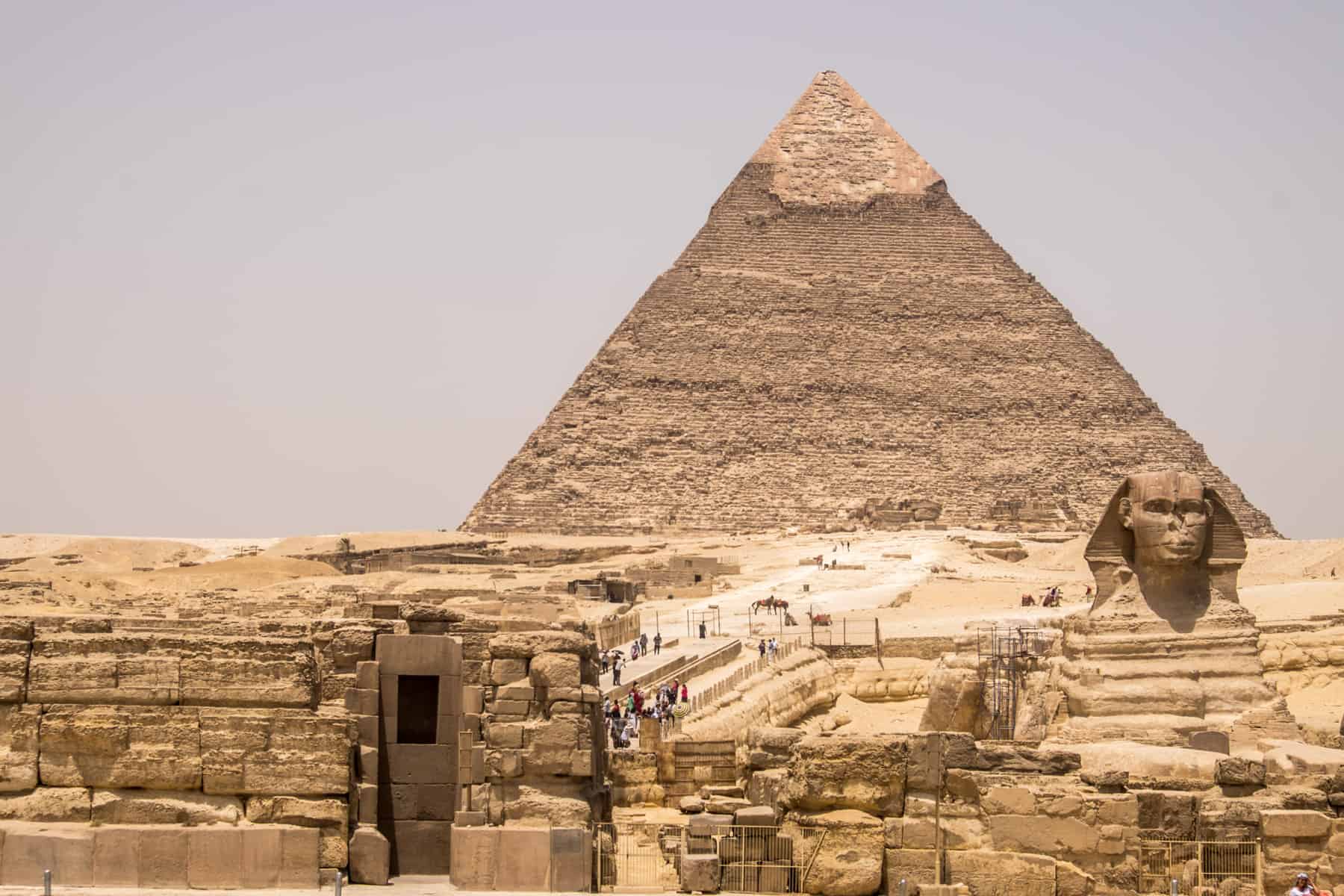
How to Travel to Egypt – Overturning Negative Perceptions of a Culturally Rich Country
Best Time to Visit Egypt
If you want to explore in a comfortable climate and escape the period of high heat, then September to April is seen as the best time to go to Egypt.
You might also want to plan your trip to avoid summer in Egypt. The hottest months, marked by the scorching, humid summer, are from May to October. More so in the South, such as in Aswan and Luxor, but it can be stifling in Cairo too.
Egypt Summer Travel
Visiting Egypt at the end of June when it was swelteringly hot, might have been a crazy decision. However, it did have its advantages. Namely, fewer crowds and the necessity to get to sites ultra-early to escape the heat but ultimately be the first in, leaving time for further exploration in the area or time to rest by the pool.
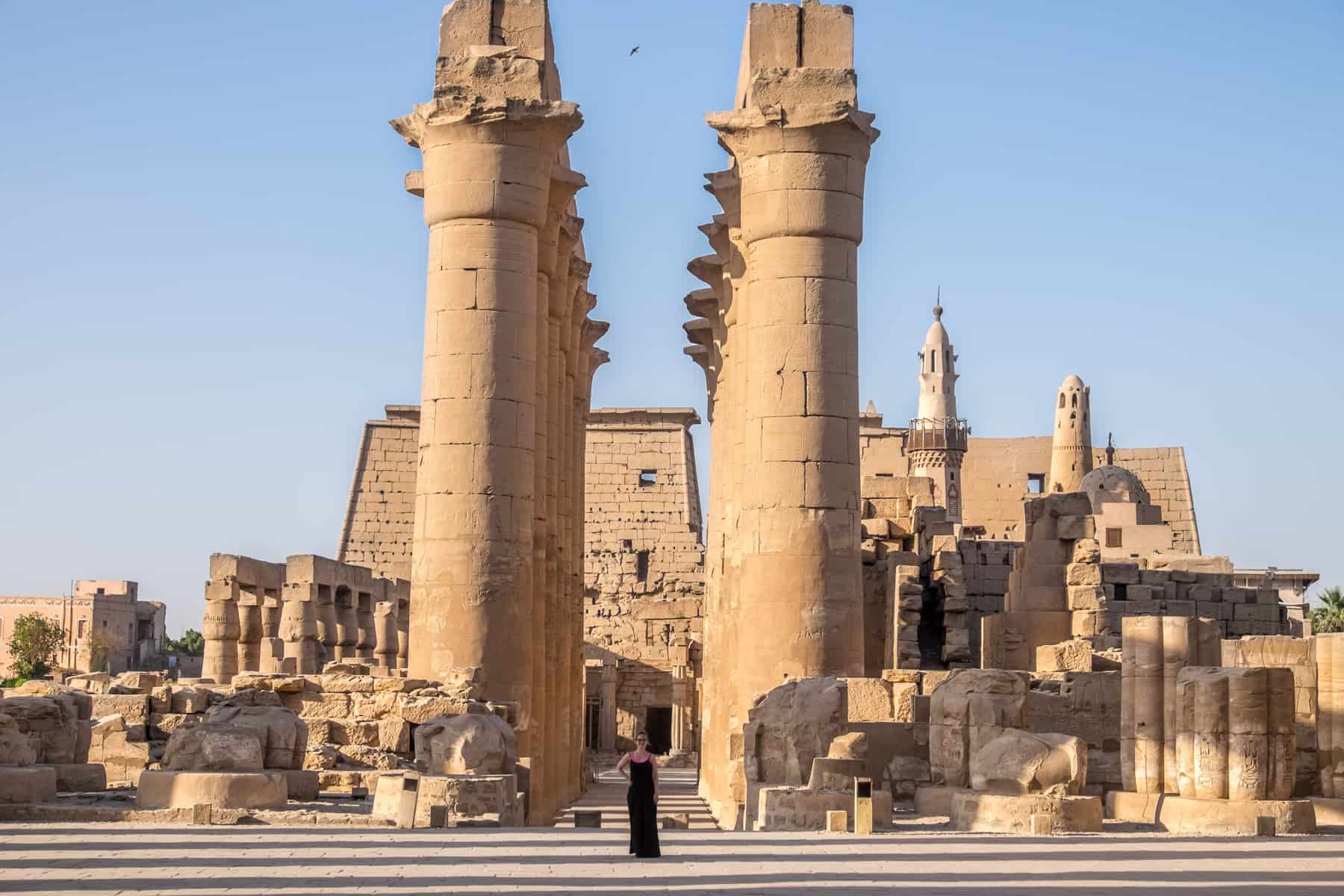
Public Holidays in Egypt
I was also travelling during Ramadan – the most important holiday in Egypt. The month-long celebration where Muslims fast from sunrise to sunset. The exact dates of Ramadan change with each lunar cycle and typically fall between April and June.
Food outlets remain closed until the evening feast time. During such times, pack snacks for the road so that you have some sustenance until dinner time, as rarely do you find the one place that remains open. Also avoid eating, drinking or smoking in public out of respect for those who can’t during that time. In the evening, people come together to feast. The atmosphere on the streets is electric and a show of community. Even in our hotels, the buffets brought people together, including friends and family of the hospitality workers.
Eid al-Fitr is another holiday and is the celebration that marks the end of Ramadan. Not long after comes the Islamic New Year, known as Eid al-Adha.
Coptic (Orthodox Christian) holidays to note are the Coptic Christmas on 7th January and Coptic Easter, which typically falls a week after Catholic Easter.
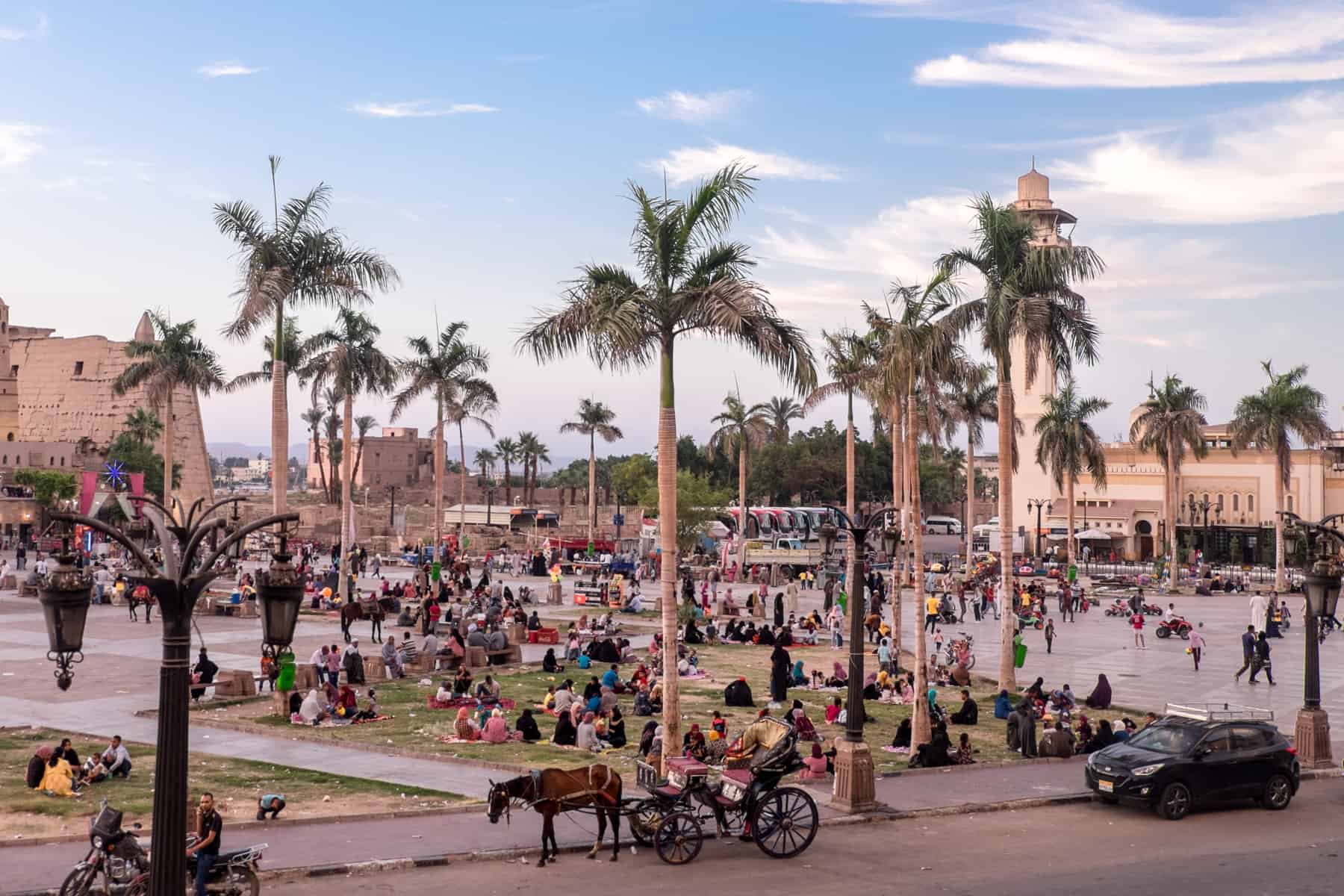
Taking a Tour to Egypt to Get Around
With my favourite small group adventure tour company, G Adventures I was able to see some of the most colossal, famous, magnificent (and still being uncovered) highlights and wonders of Egypt. This trip included Cairo, Giza and the Great Pyramids, Alexandria, Aswan, Philae Temple, Abu Simbel, Kom Ombo Temple, Luxor and the Valley of the Kings, alongside added excursions to Saqqara and Memphis.
A Responsible Tour of Egypt
Egypt tours are plentiful, but it’s important to choose one that opts for certification and responsibility.
Not only did I traverse a lot of sites, but I travelled Egypt and some of the most revered wonders of the ancient world with a local and a certified Egyptologist – the G Adventures Chief Experience Officer who has an education in Archaeology, knows every conceivable detail about the history and who volunteers his time in helping to uncover ancient sites today.
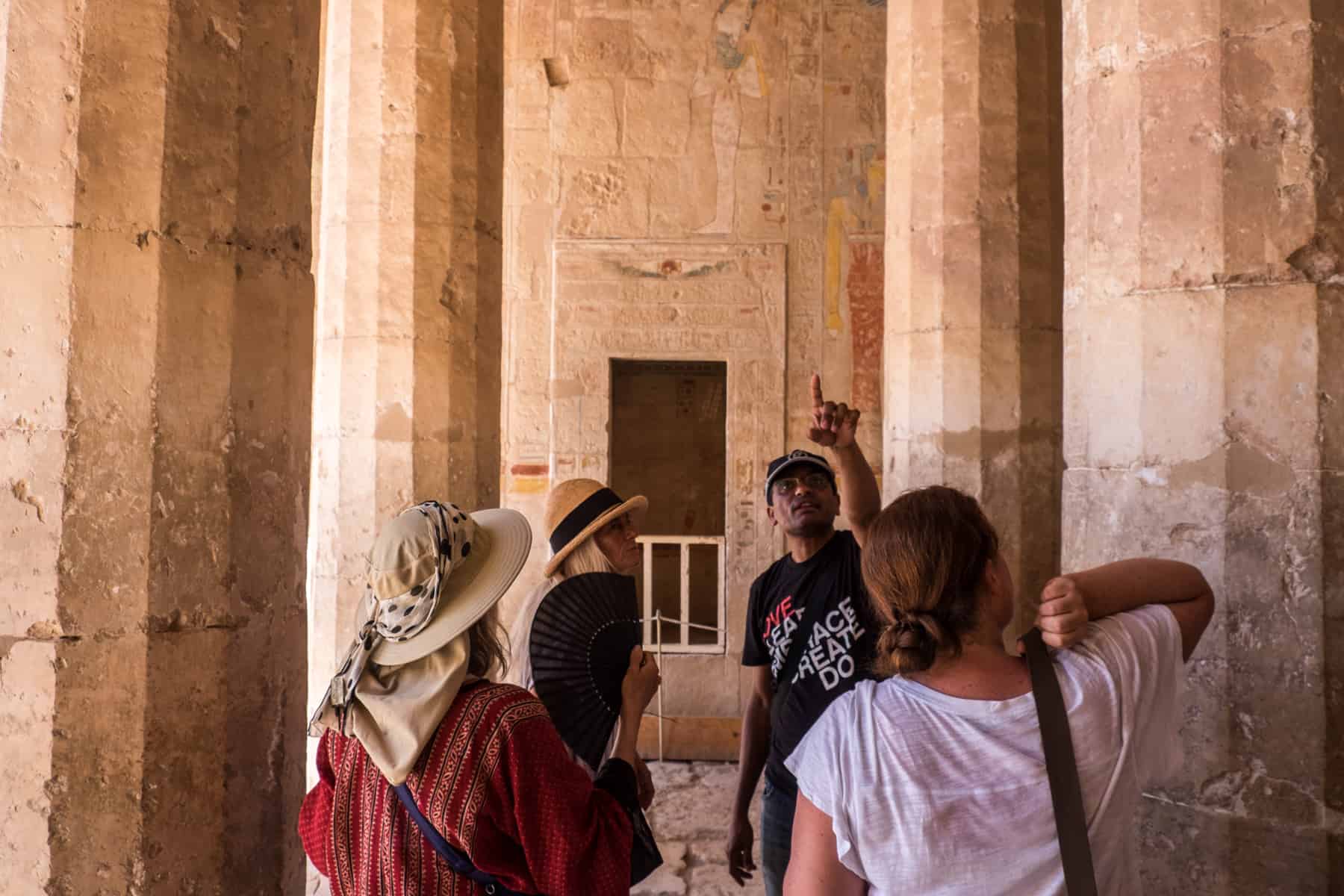
Not to mention travelling for social good, where we were able to support local families during a Nubian village visit in Aswan where we ate a home-cooked dinner. As a G Adventures ambassador, I travel to destinations responsibly and with purpose and show how you can too.
Many people grapple with the idea of arranging everything in each city and traveling to Egypt independently, which is doable but with a lot more hassle, or choosing the comfort of a small group where the main components of travel are organised. For many people on my trip, the group tour option also relieved safety concerns.
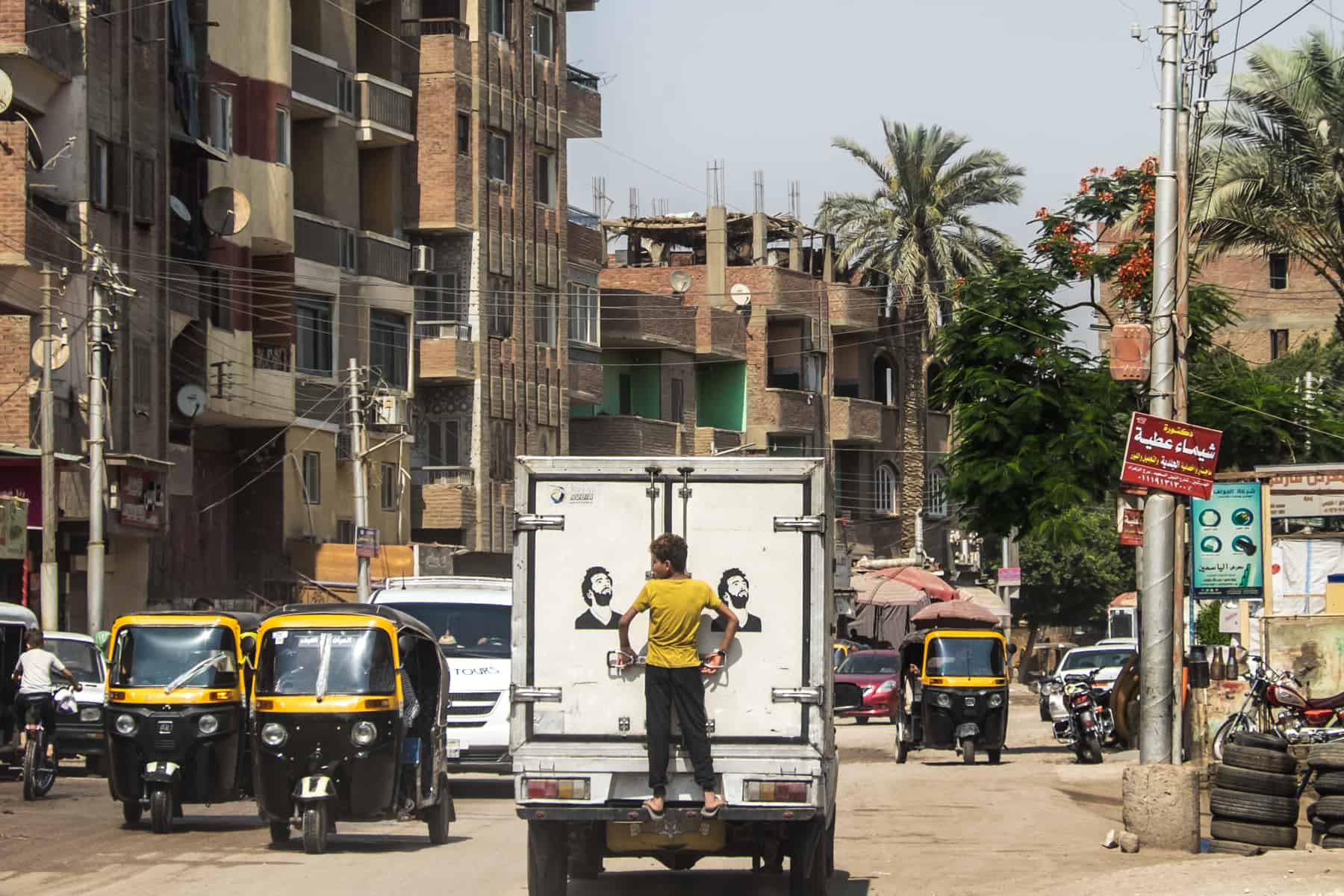
Deciding on the Best Egypt Tour
My G Adventures Egypt Upgraded tour covered the listed sites above, including the Nile Cruise and out-of-the-way Abu Simbel excursion. The upgraded element relates to the fact this is designed to be more of a comfort tour. There are seven tours altogether to choose from, all including some of the famed sites in Egypt different measure, including:
- Egypt on a Shoestring for those wanting the ease of organisation with minimal costs, Overlanding using public transport and floating down the Nile on a felucca
- Shorter trips like Best of Egypt, which covers Cairo, Luxor and Aswan, including sailing the Nile on a traditional felucca and the Luxor to Cairo flight
- A chance to visit the Red Sea area on the Highlights of Egypt trip which includes time in coastal Hurghada an overnight train to Aswan and a felucca sail between Aswan and Luxor
Egypt guided tours don’t necessarily have to be stifling. During my trip, I have plenty of time to rest, explore each town and city, and after initial insight at an ancient site, was left with time to explore on my own.
Where to Go in Egypt
From temples and tomb hoping while crisscrossing four major cities, you will uncover a multitude of ancient sites that you may have to pick and choose from according to what time you have. The main reason why you travel to Egypt, after all.
READ MORE: On the best places to visit in Egypt – a list of all the major historical and famed sites in further detail which you can use to plan your preferred Egypt itinerary.
Cairo – The Last Remaining Ancient Wonder of the World
Visit Egypt’s most iconic site – the Great Pyramids of Giza and the Sphinx at the remote desert area of Giza west of the Nile River, before visiting The Egyptian Museum. With 10,000 artefacts are documenting every period of Egyptian history, showcased treasures include the tomb of Tutankhamun and the Egyptian Mummy Room.
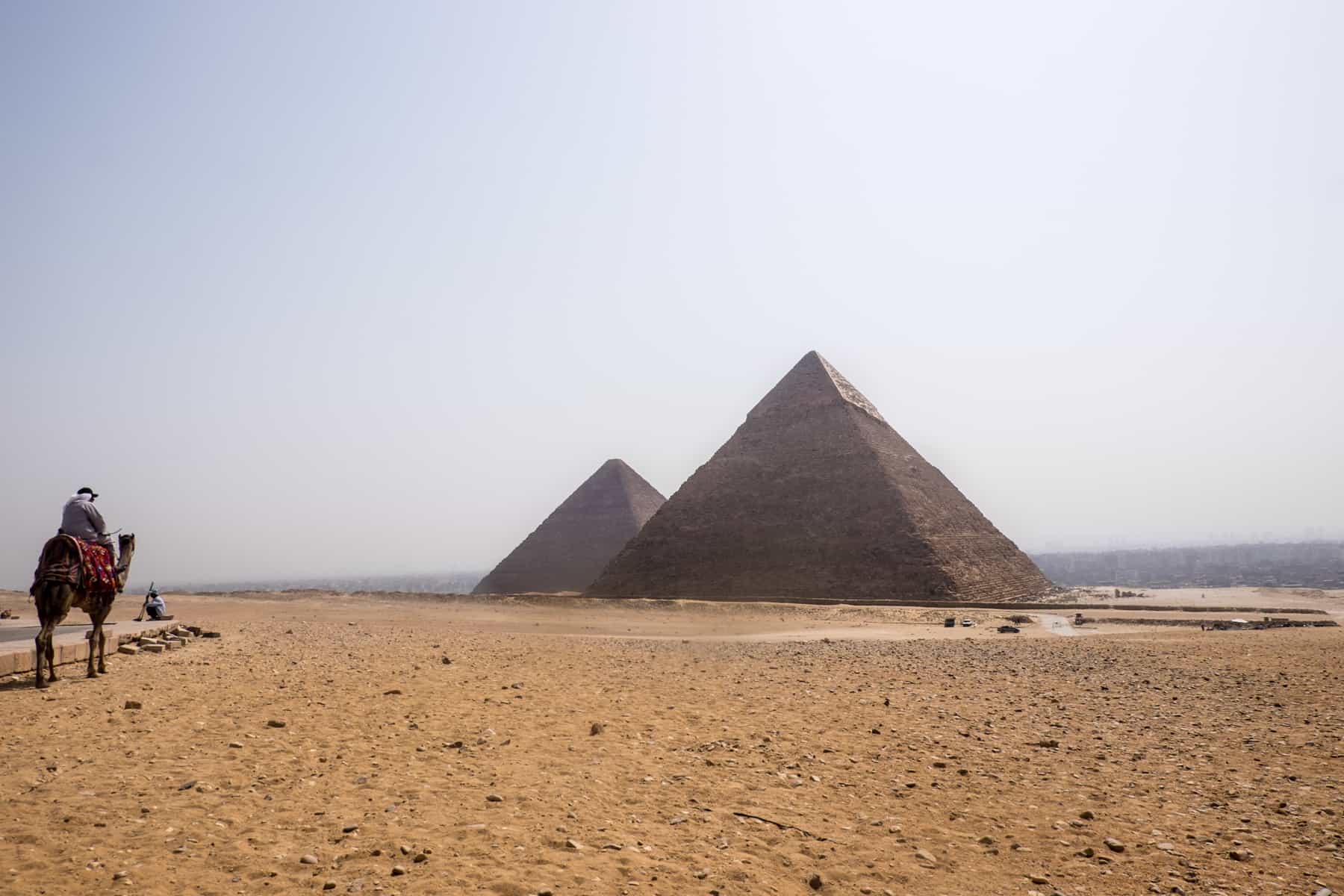
In the city, visit the Khan El Khalili Bazaar for local goods such as gold, silver, copper and perfumes and tour Islamic and Coptic Cairo where sites like the Hanging Church and Sultan Hassan Mosque show a city where different faiths stand side by side.
2.5 hours drive south of Giza is Memphis – the ancient capital of Egypt, where you can view the massive statue of Rameses II. Nearby Saqqara – the site of Egypt’s first Pyramid, is an important archaeological site of noble family tombs, in the early stages of being extensively uncovered, with new finds recorded in April 2020.
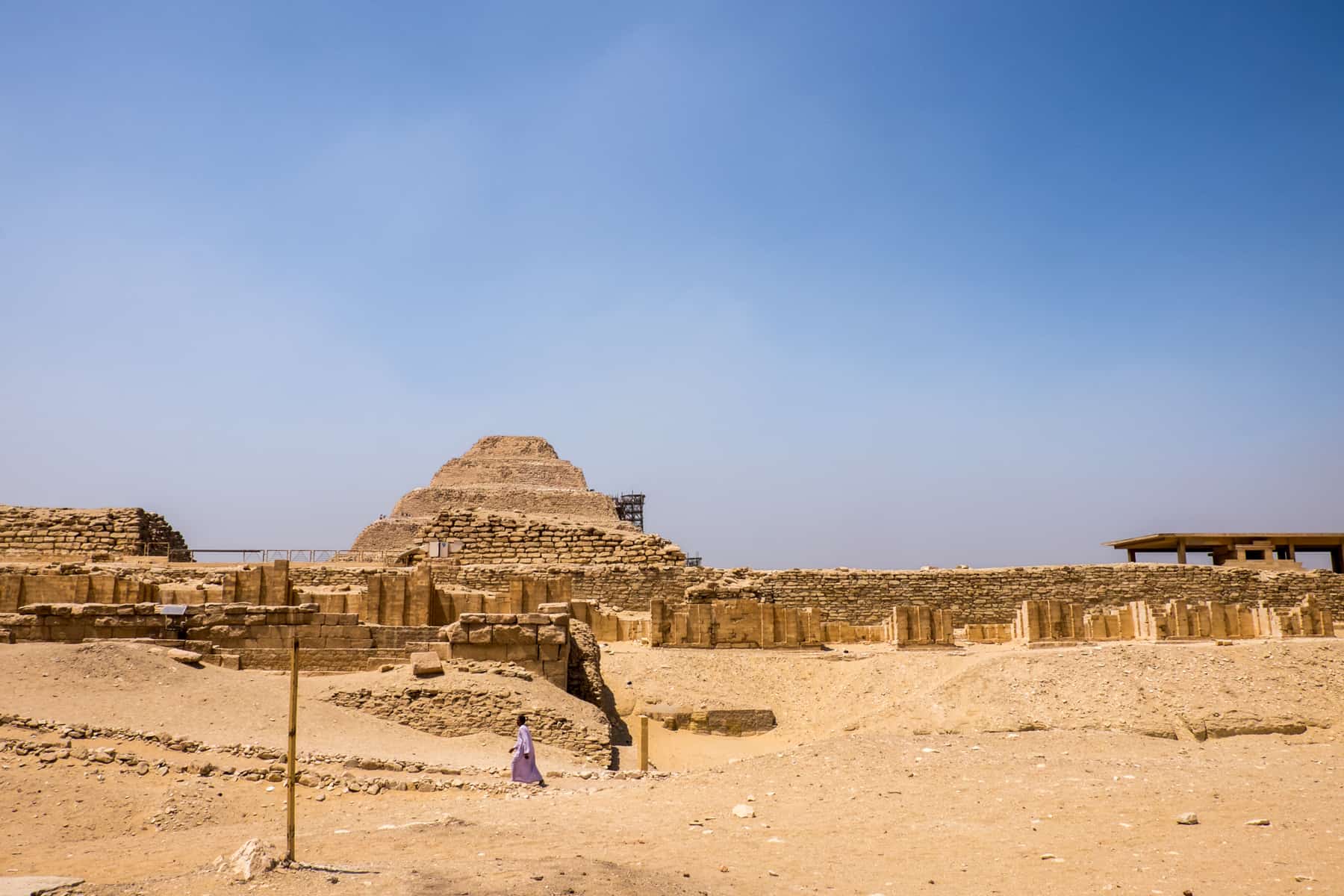
Old Town Alexandria – European Character and Mystery
Travellers often overlook the northern city of Alexandria on the Mediterranean coast.
The main sites include Pompey’s Pillar – a Roman 20-meter tall victory column from a 297 AD Roman temple complex, and the Catacomb of Kom ash-Shuqqafa – a 2nd Century resting place for a wealthy family who was still practising the ancient religion of Egypt.
The Library of Alexandria was one of the greatest and most famous libraries of the ancient world, destroyed by a fire in the 1st Century BC. Today, a new library stands just meters away from the estimated location of the ancient one, with the same ethos as a centrepiece knowledge, available to all.
Aswan – Nubian Egypt
A three-hour drive south of Aswan is Abu Simbel – considered to be one of Egypt’s most beautiful temples. The two rock temples carved out of mountainside were built by the Egyptian Pharaoh Ramesses Il between 1274-1244 BC – one dedicated to himself in godlike form, and one for his wife, Queen Nefertari.
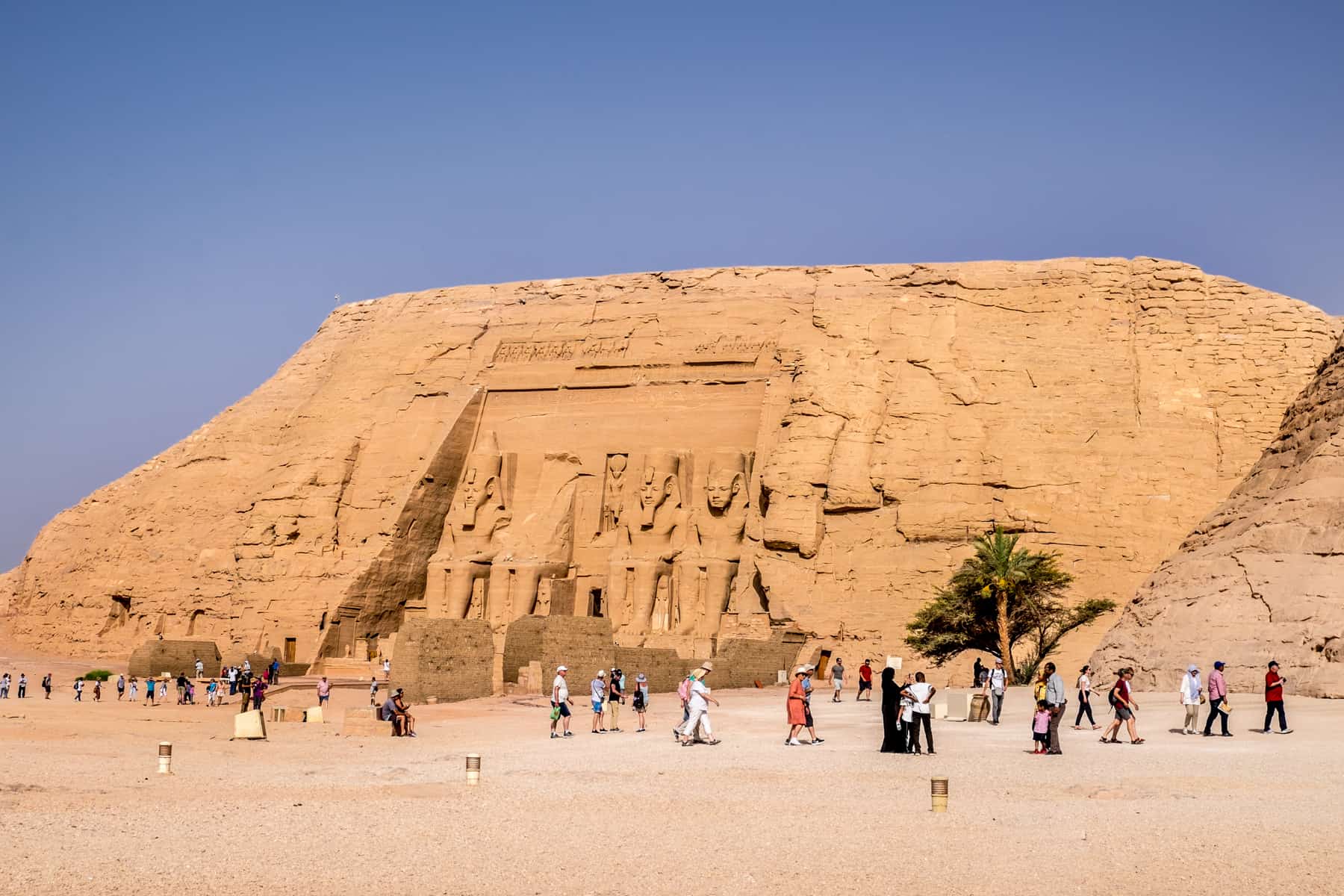
Island-bound Philae Temple is a monument where Greek-Roman history in columns that line the exterior entranceways sit alongside Ancient Egyptian, where the last use of Egyptian hieroglyphs adorns the inner walls.
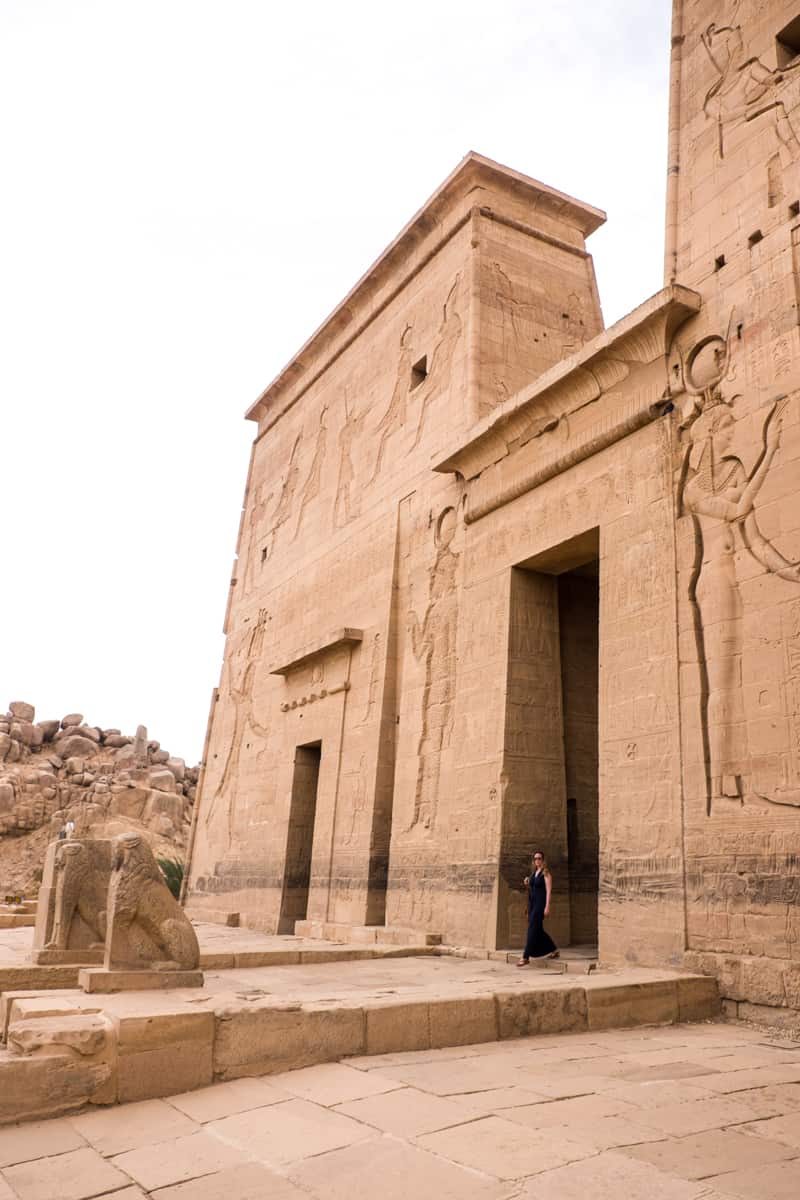
In Aswan, head to the ancient quarry to see the Unfinished Obelisk – the tallest Egyptian obelisk ever erected until a considerable crack appeared during the carving process. Finish the day with the sounds of vendors hawking their wares at the Sharia el Souk market where you can shop local for textiles and spices, including the famed Aswan black pepper.
Then board a felucca manned by a local from one of the Nile islands before visiting a Nubian village home for a walking tour and a delicious traditional dinner. The Nubian culture is one of the oldest in Egypt and one of the earliest civilisations found in ancient Africa. The host family can use this ‘local living moment’ on our trip as a regular source of income, where your money stays in local hands.
Take a Nile Cruise Between Aswan and Luxor
Travel upriver on a two-day three-night adventure, passing desert oasis scenery and stop for a visit to Kom Ombo Temple for sunset.
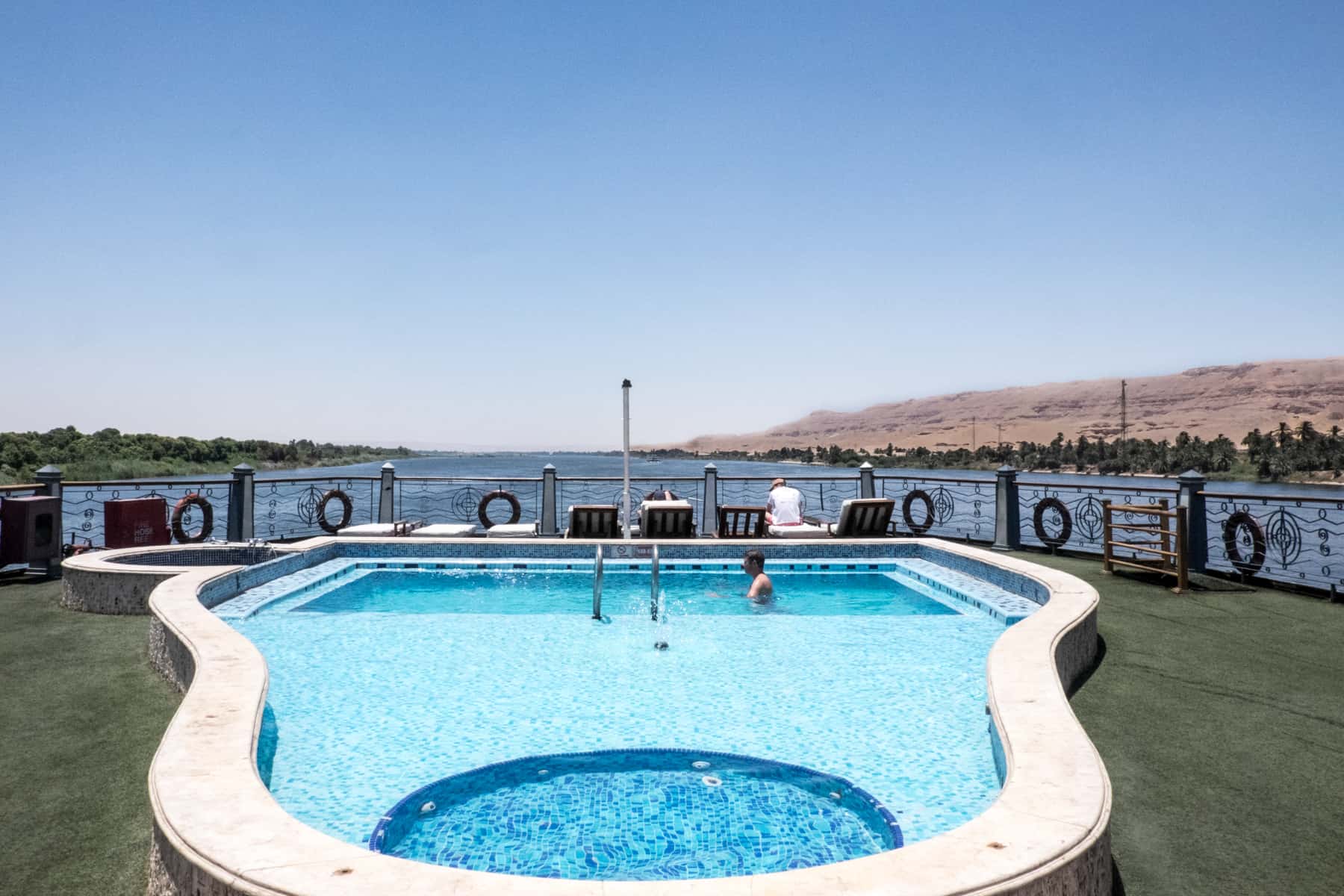
Kom Ombo was built during the Graeco-Roman period (332 BC-AD 395) and dedicated to the crocodile god, Sobek and the falcon god Horus. Mummified crocs found during excavation are also on display.
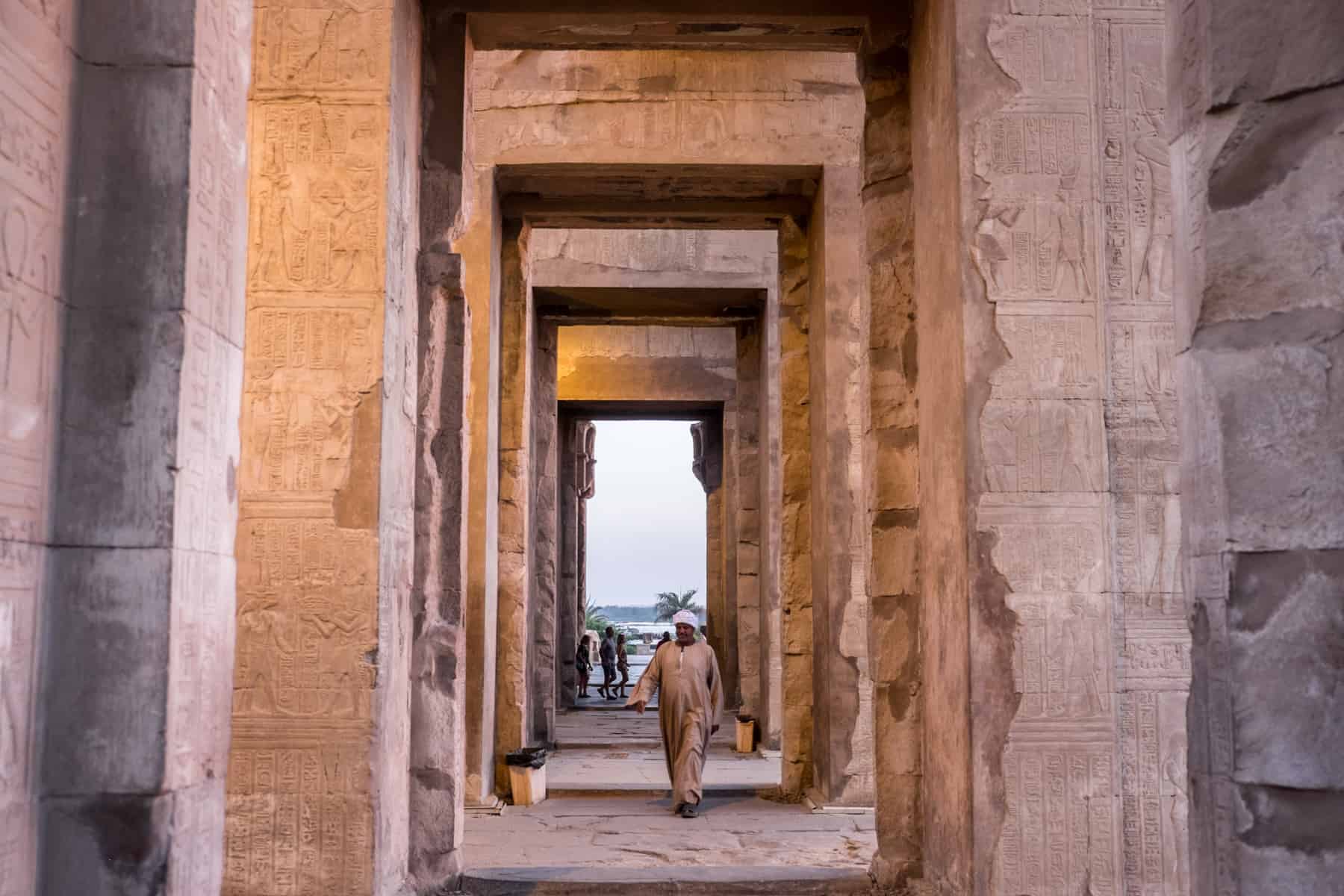
Luxor – Land of the Greatest Pharaohs
No trip to Egypt is complete without visiting the vast archaeological site of the Valley of the Kings located on the ancient site of Thebes in Luxor’s West Bank. This fascinating network of tombs and tunnels is an ancient burial ground and the final resting place for Egypt’s New Kingdom rulers.
The ticket for the Valley of the Kings grants you entrance to three tombs out of the 63 on-site with the most impressive being the tomb of Ramses IV and Tutankhamen’s tomb which is worth the extra ticket cost and to complete the story after viewing his treasures at the Egyptian Museum.
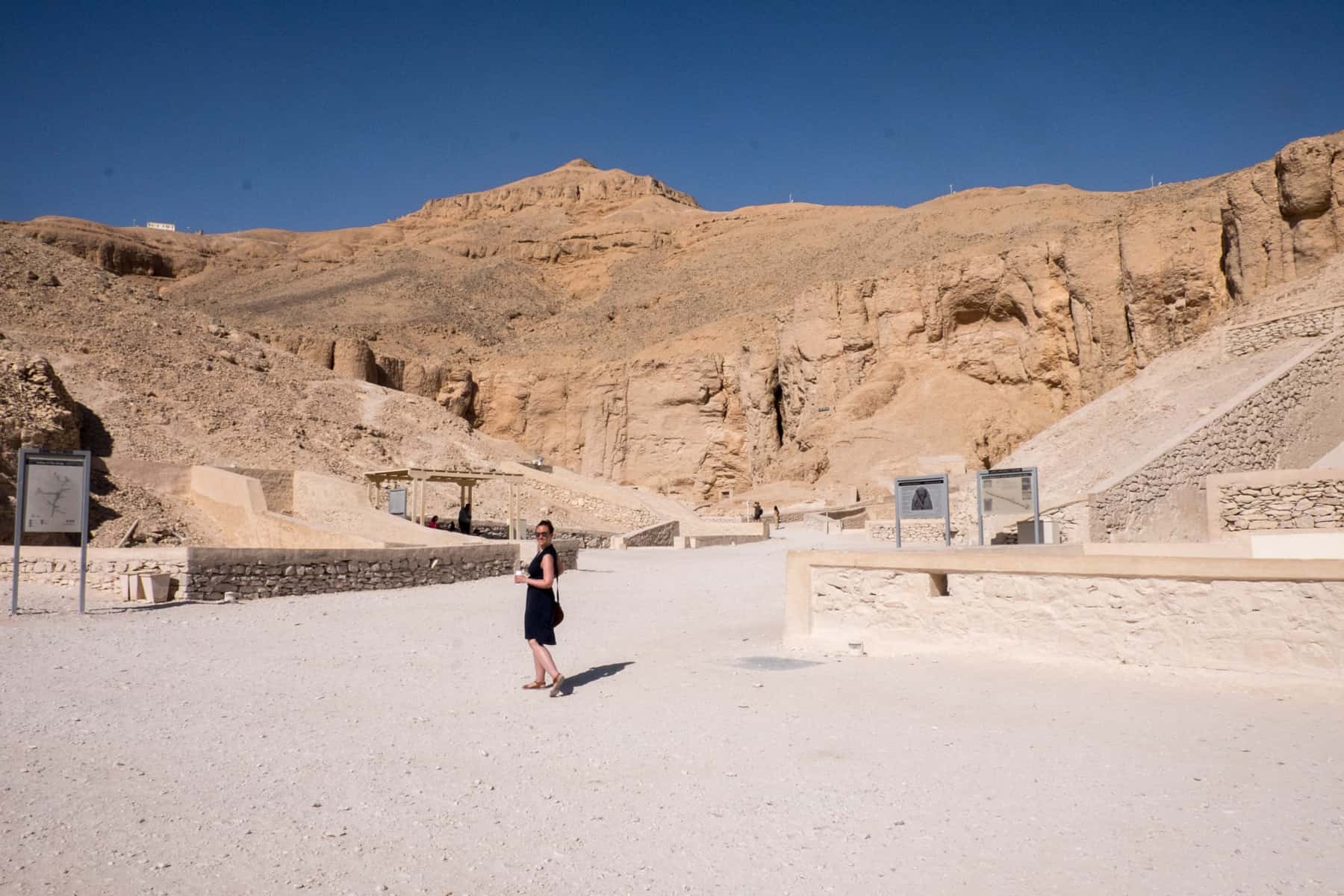
The tiered complex built into limestone rocks of Temple of Hatshepsut is a symbol of the power of female rulers to the throne of Egypt Queen Hatshepsut disguised herself as a man, which is why you will still see carvings of the typical Pharaoh figure.
Close by are the two towering statues of Amenophis II at the Colossi of Memnon site – centrepieces from the front of a grand temple that no longer stands.
In Luxor town, visit Karnak Temple, which was once the centre of all religious life in Egypt and built and extended over and over by generations. Linked by a recently uncovered two-mile Sphinx Alley, complete your sightseeing with a Luxor Temple visit. Ancient Egyptian, Coptic Christianity and Islamic architecture intertwine throughout the temple showing its evolution in worship over the thousands of years since its construction in 1390 BC.
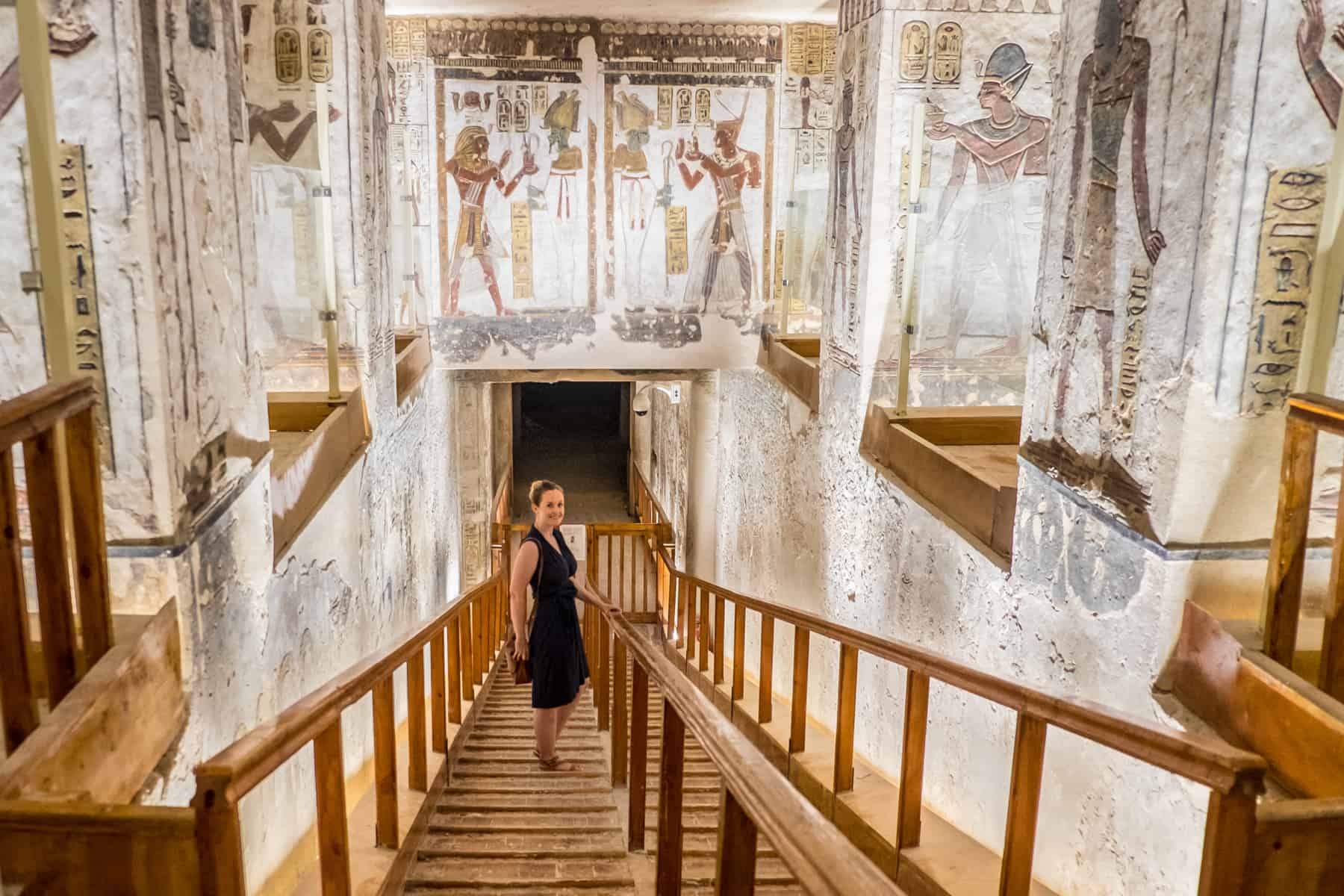
Is it Safe to Travel to Egypt?
Whether sun lounging and diving in the Sinai Peninsula and the Red Sea Resorts such as Sharm El-Sheikh, or chasing history on the Cairo-Luxor-Aswan trail; Egypt has long been a popular tourism destination.
Until the Arab Spring of the Egyptian Revolution of 2011 shut the country down for years as political upheaval spread throughout the country, and terrorist attacks became commonplace. It’s not uncommon to think or ask: “Is Egypt safe to travel to right now?”
Right now is the ever-changing part of the question. While those tumultuous days are over, sporadic attacks still occur, and you should keep up to date with political news and your government’s advice on travel to Egypt before you leave.
Therefore, one can’t say Egypt is 100% safe at any time, but it’s safer than what the media will have you believe. It’s best to keep to the marked route of main destinations and sites, hire a private guide (for all or parts of your trip) or choose a responsible tour operator.
It pays off to be an astute and smart traveller at all times, constantly be aware of your surroundings and not venture off-track. Also, avoid protests and demonstrations that have the potential to turn violent with no warning.
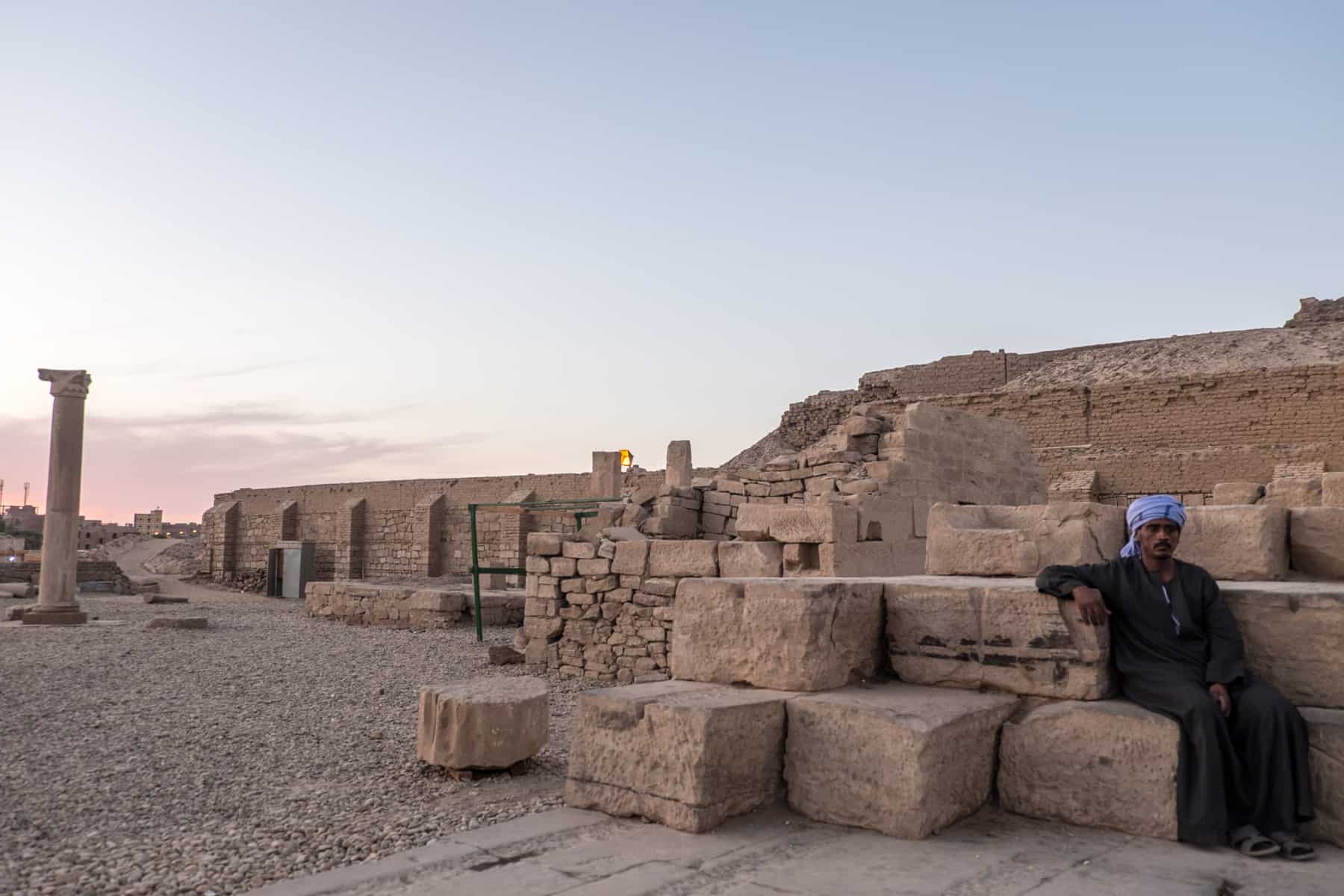
Unsafe Areas of Egypt to Avoid
The areas deemed unsafe in Egypt, according to the UK Foreign and Commonwealth Office are:
- The Sinai Peninsula, especially the north, except for the Red Sea resorts of Sharm el-Sheikh and Hurghada due to criminal activity and terrorist attacks.
- Egypt to the Gaza (Occupied Palestinian Territories) border, and any other land border area which is a military zone.
- The Western Desert, west of the Nile Valley due to armed groups in this area near the border with Sudan or Libya.
- The Hala’ib Triangle, which is a disputed territory between Egypt and Sudan.
The Egyptian Tourism and Antiquities Police
With tourism being Egypt’s major economic lifeline, tourist safety and tourist site security are well managed and executed by the Egyptian Tourism and Antiquities Police, as more and more visitors return to this cultural heartland.
It means that everything from the entrances to ancient sites and hotels, as well as significant landmarks within city centre limits, has security machines and guards in place. These measures are alongside roadside checkpoints, vehicle checks and tourism police operating a well-oiled machine to ensure everyone can get around the country with ease and that all sites remain open for full exploration.
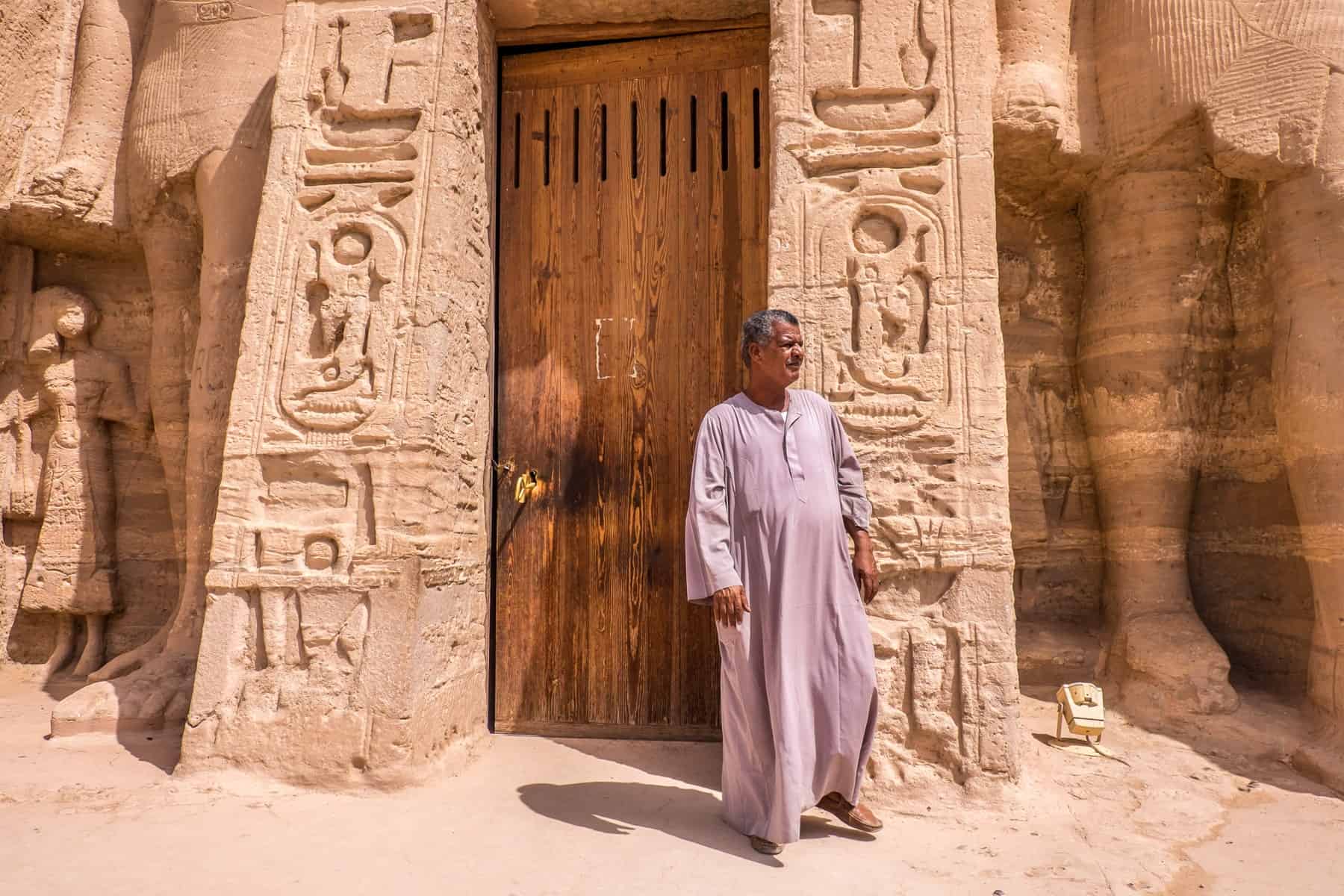
I never once felt unsafe, but I did see and sense the maximum security in place, which can be a shock to some people at first especially if you are not used to travelling in post-conflict destinations. Such scenarios included an armed plain-clothed security guard in our car when driving all-around Alexandria and a six-manned police truck escorting us out of a quiet desert area after visiting a well-known monastery. Like any destinations, some neighbourhoods are safer than others.
Altogether, it is not something to be alarmed by, but its good to understand why such measures exist. Tourism in Egypt is the largest and most easily decimated economic target in a politically fragile region, with on-going frictions with neighbouring countries.
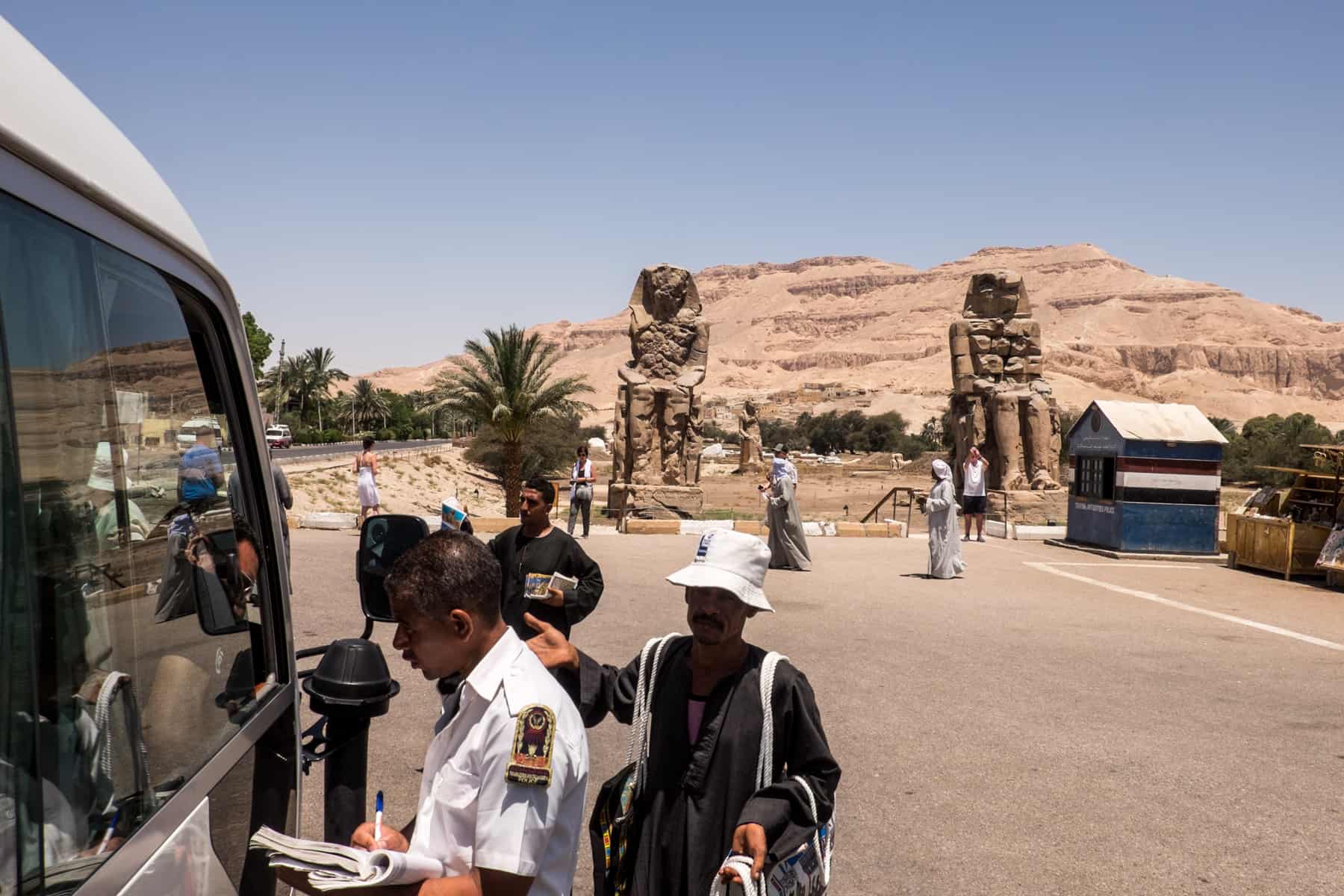
Independent Travel in Egypt and Group Travel Safety
Solo travel in Egypt is not at all impossible but is at your own risk. When travelling with a private guide or in a small group, your itinerary, even down to some of the hotels and restaurants, will be pre-approved by Egypt’s tourism police.
Booking a guided itinerary means you can’t veer off course and decide to visit somewhere sporadic at the very last minute. That extra day excursion you want to book? It has to be pre-approved so that the tourism police know who will be where. When travelling on a group trip with G Adventures, our Chief Experience Officer (CEO) had the authority to amend or cancel any part of the trip itinerary if it was deemed necessary due to safety concerns. Our CEO also had to accompany us on all included activities, where he was also the guide.
Anything planned outside of the itinerary, such as free time and exploring at our leisure, means releasing the company you are travelling with from any responsibility concerning your safety. However, the company can still be liable and blamed as your presence in the country is listed under its operation.
Vendor Hassle in Egypt
Egypt’s vendors at major sites live up to the reputation of extreme hassling.
You can never walk in a bazaar or the main streets in Egypt in peace. You can’t make eye contact or look at a single item or storefront without entering into a potential transaction. It’s constant, it’s tiring, and it can affect your ability to simply be curious and try and observe daily life around you. While there are some you can have banter with (should you choose to engage), it is best to ignore.
However, as frustrating as it is (especially since you can’t walk anywhere on the street without hassle) there is the other side to it we need to remember. That of desperation, in a developed country sidetracked by political upheaval where tourism dollars mean everything. Especially at a time where the main lifeline of tourism has been hit and continues to be while Egypt tries to catch a break.
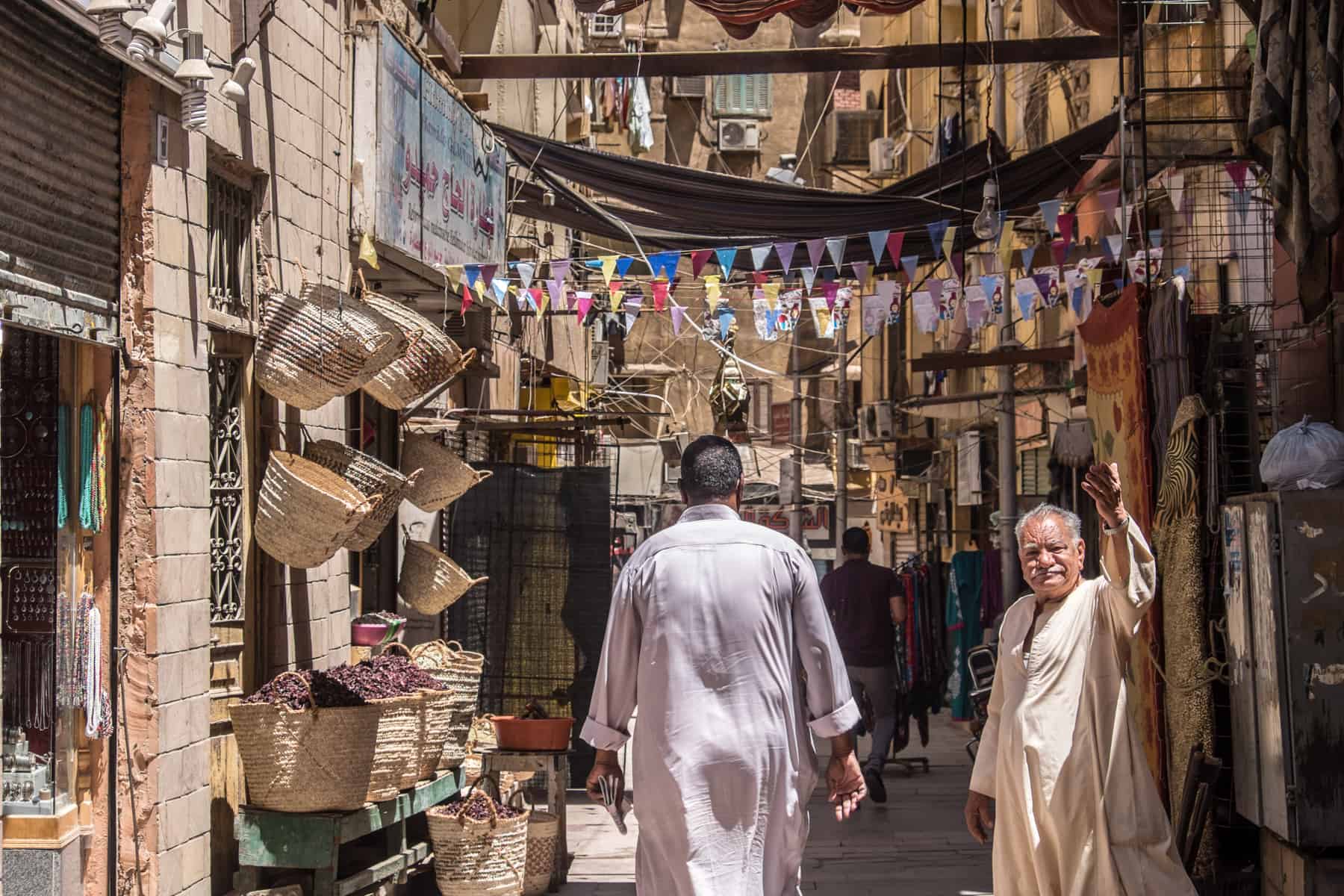
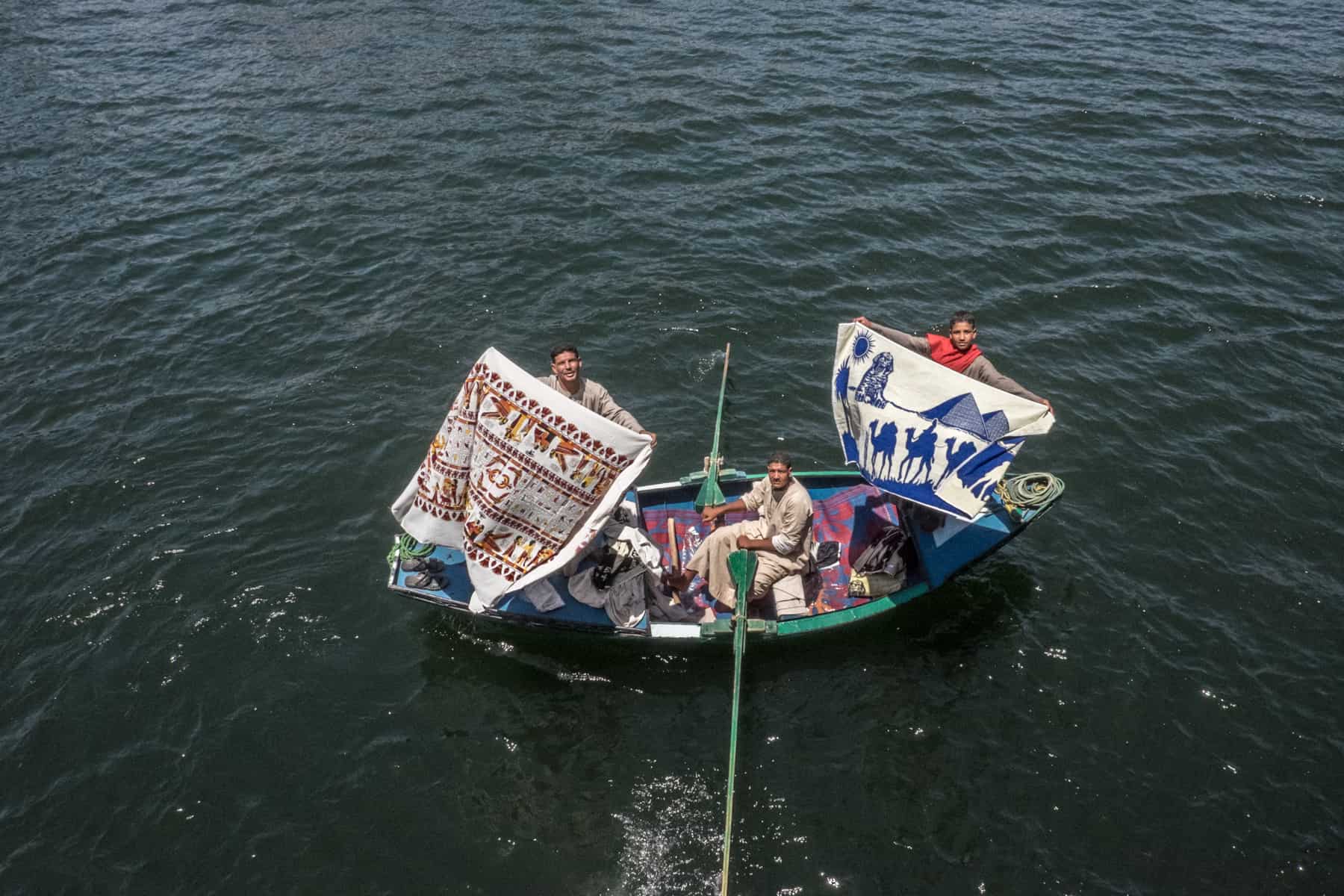
Is Egypt Safe for Women?
For women travelling on their own in Egypt, there can be a heightened cause for concern for two main reasons. One, because of the insistence to engage from local men where it is best not to look at them or respond to any kind of contact at all and secondly because the desperation from economic instability is what is bringing out the worst in people here. Like everywhere, it’s always a few who give the majority a bad name, so I refrain from branding all Egyptian men.
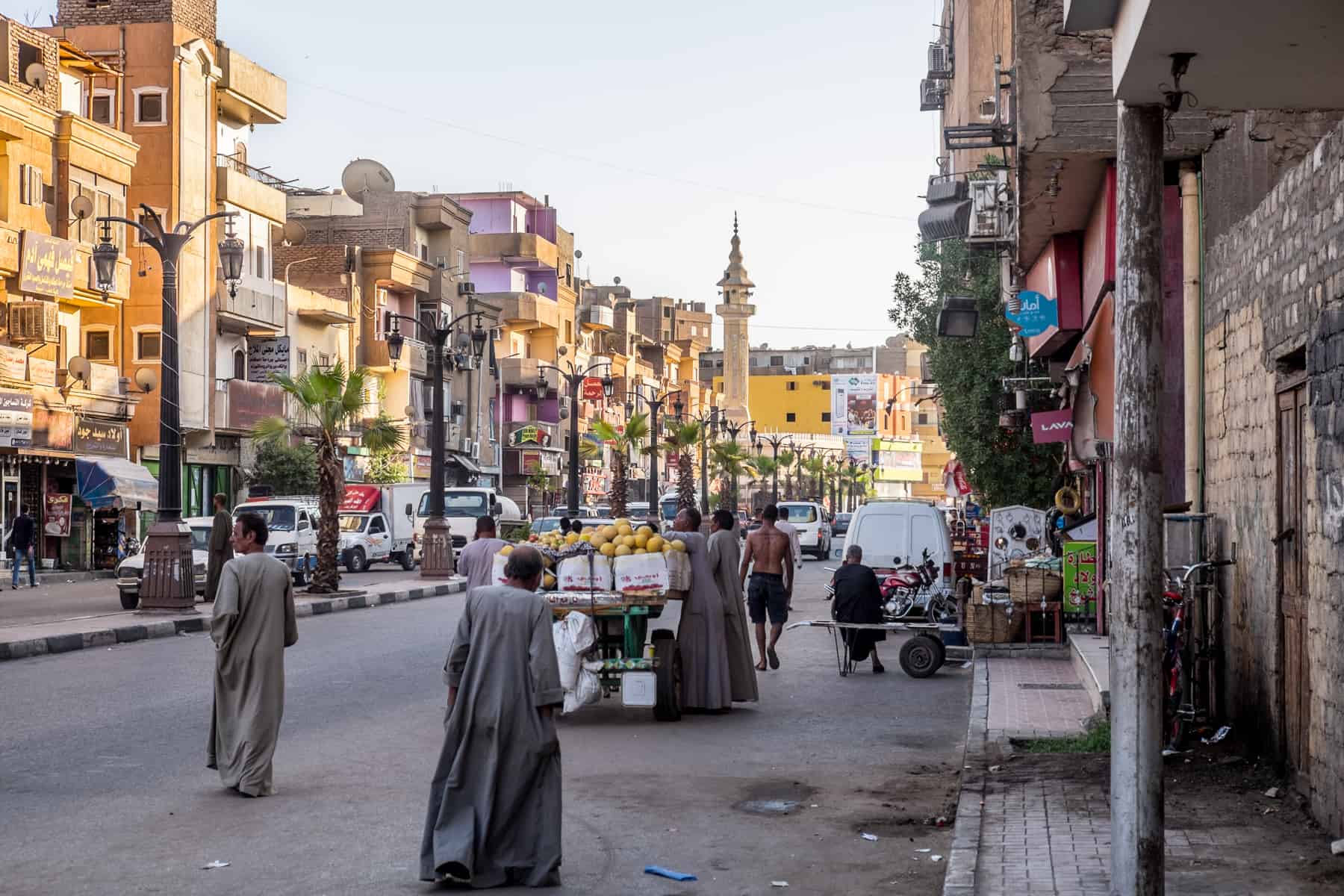
However, while I never felt any of my experiences would escalate into any kind of violence, it was very warring to have to be in a heightened state of awareness everywhere we went, and the need to do the following:
Curb your curiosity for further exploration. Going for walks in neighbourhoods and areas more than a block or two away from a main site or souk in all Egypt destinations is not recommended.
Be aware that you could be followed. A fellow female traveller and I decided to spend some time wandering around the centre of Aswan and the Souk, and we were followed back to the Nile coastline (where our cruise boat docked) for over 10 minutes. Regardless of how many times we asked the man to leave, he didn’t. He only did when my friend screamed in his face, and we were back where tourism police were lining the roadside near the tourist boats.
Stay assertive. In Luxor, our random walk in the city was cut short when we realised we were not going to get a moment’s peace. I even had to threaten to call the police on a horse and cart driver who would not let us pass on the street while trying to sell his services. While answering back may cause heightened tension, it is still necessary to make your feelings clear.
Take Taxis, especially at night. Usually, we would stay in small groups and took taxis to and from restaurants and markets, or during evening excursions. I used Uber in Cairo and had no issues at all and for a reliable and friendly taxi driver in Luxor, contact this guy.
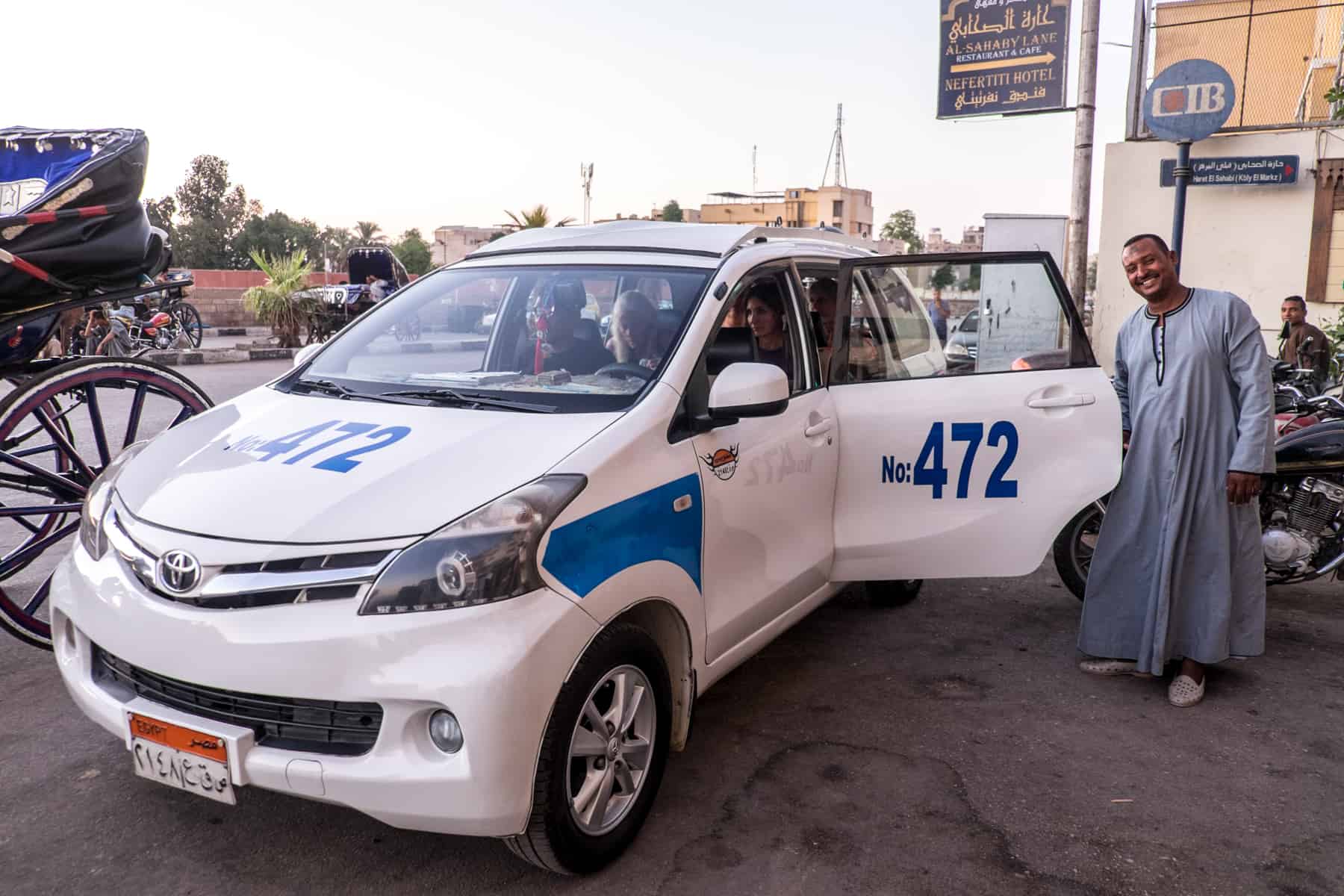
Getting Your Egypt Visa and Entry Requirements
Egypt Visa on Arrival
A host of nationalities including all Western European and Arab countries, USA, Australia and New Zealand, can obtain a one-month single entry visa on arrival at Cairo International airport or at the Egyptian land border. All countries entering Egypt require a valid passport (with a minimum six months validity).
I also had a copy of my itinerary and details of the hotel I would be staying at on my first night, just in case border control asked for extra information.
If you want to purchase an Egypt visa on arrival, you must pay in cash. The visa fee is 25 USD (or equivalent) ONLY with US Dollars (USD), Euro’s (EUR) and the British Pound. Egyptian pounds and credit cards are not accepted payment methods when obtaining your Egyptian entry visa.
Look for windows (marked “banks”) selling these visas in the area where you line up to have your passport stamped. You need to get the visa before entering the passport line. The visa is a sticker, which you need to stick into your passport before handing it to the authorities for stamping.
Egypt E-Visa
I choose to get an Egypt E-Visa – a recently introduced electronic travel authorisation system for from the following eligible nationalities wishing to travel to Egypt for tourism:
Albania, Australia, Austria, Belgium, Bulgaria, Canada, Croatia, Cyprus, Czech Republic, Denmark, Estonia, Finland, France, Germany, Greece, Hungary, Iceland, Ireland, Italy, Japan, Latvia, Lithuania, Luxembourg, Macedonia, Malta, Moldova, Monaco, Montenegro, Netherlands, North Korea, Norway, Poland, Portugal, Romania, Russia, Serbia, Slovakia, Slovenia, South Korea, Spain, Sweden, Switzerland, United Kingdom, United States, Ukraine, The Vatican
The e-Visa for Egypt is either a single or multiple-entry visa, valid to use for three months and gives the visitor a maximum duration of 30 days in Egypt for tourism. You can apply via an online application without the need to visit the embassy. It is a simple process that also saves time and hassle upon landing and gives you peace of mind before your trip that you have a visa for entry already secured.
Details about the Egypt Online Visa commonly asked questions on visa fees, requirements and eligibility to apply can be found here.
What to Wear in Egypt
Trying to fathom what to wear in Egypt as I was packing for the trip was stressful. Knowing I would be crossing different cultural scenarios, exploring in extreme heat and trying to choose items I knew could be sacrificed to the ruin of sweat-drenching and dusty scenarios.
While no particular rules of attire exist at temples and tombs, it pays to be respectful of the culture and always be modestly dressed. So even though shorts, singlets and dresses to the knee at tomb and temple sites are not frowned upon, generally you should wear loose-fitting clothes that cover knees and shoulders. More so at markets and public areas. For mosques and other religious sites, you must be covered up and wear a shawl or headscarf.
Also, take plenty of clothes are you will quickly get dusty, dirty and very sweaty.
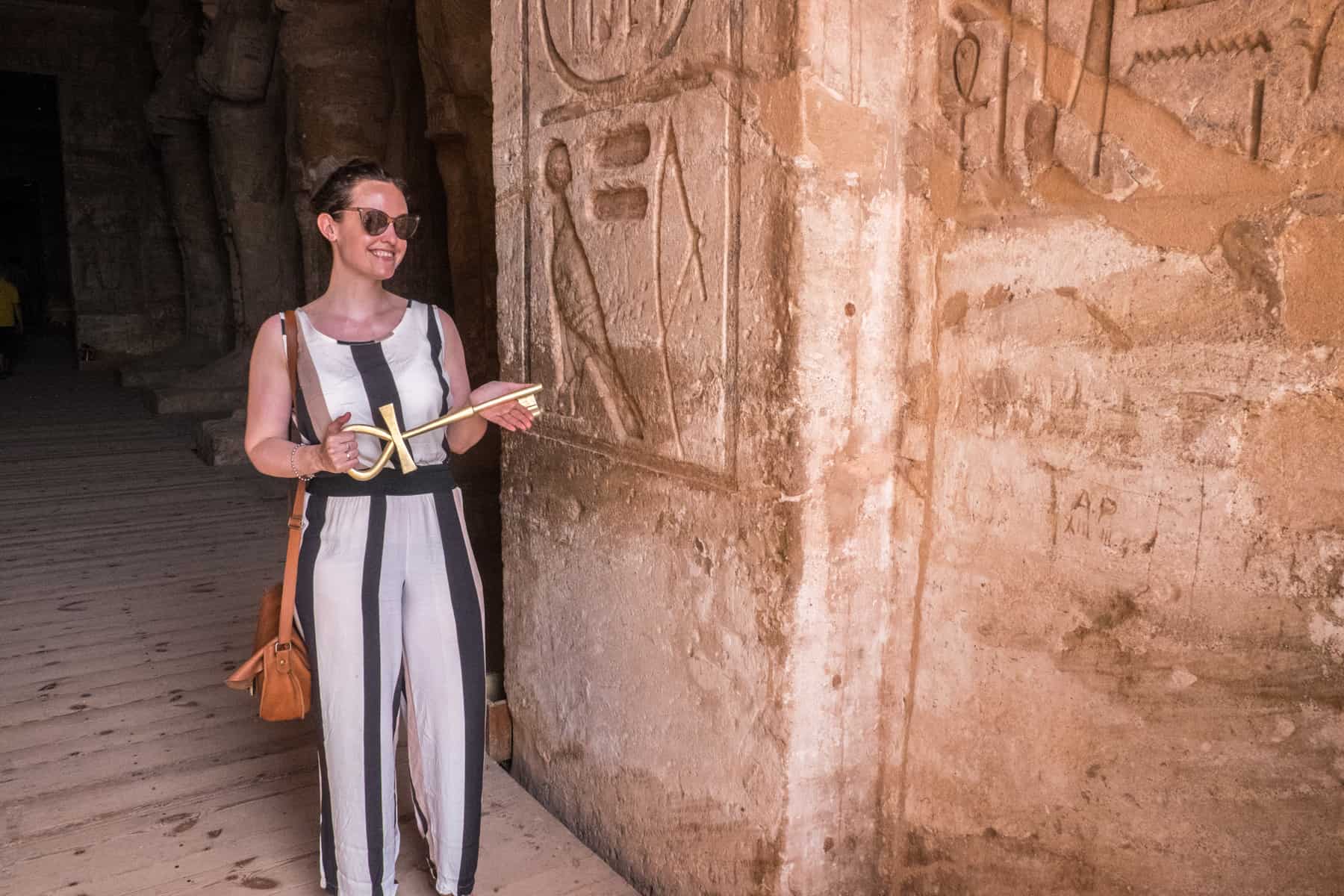
Conservative Dress
- I packed two maxi-dresses and two jumpsuits that could be worn with loose-fitting t-shirts and light blouses to cover my shoulders.
- Long, loose pants and long, over the knee skirts are also useful clothing items.
- I scarf or shawl for mosques and other religious sites.
- A hat for the extended site visits, if you are ultra-sensitive to heat.
Other Dress
- The temperature during Egyptian nights can drop and evenings get chilly, so a light fleece or jacket or cardigan comes in useful to layer up.
- Swimwear and a travel towel – for the afternoons you will spend by the pool and basking in the sun on the Nile Cruise
- Waterproof jacket – Rain is not frequent, but neither is it uncommon, especially the further north you are where it is cooler in temperature.
Footwear
- I took one pair of open-toe sandals and one light pair of walkers (Vivo Barefoot).
- Hiking shoes are not needed, just comfortable walking shoes for when you will be wandering the sites for up to three hours. It also pays to have shoes with a good grip due to steep slopes in tombs, Pyramid entrances, as well as sandy and rocky landscapes.
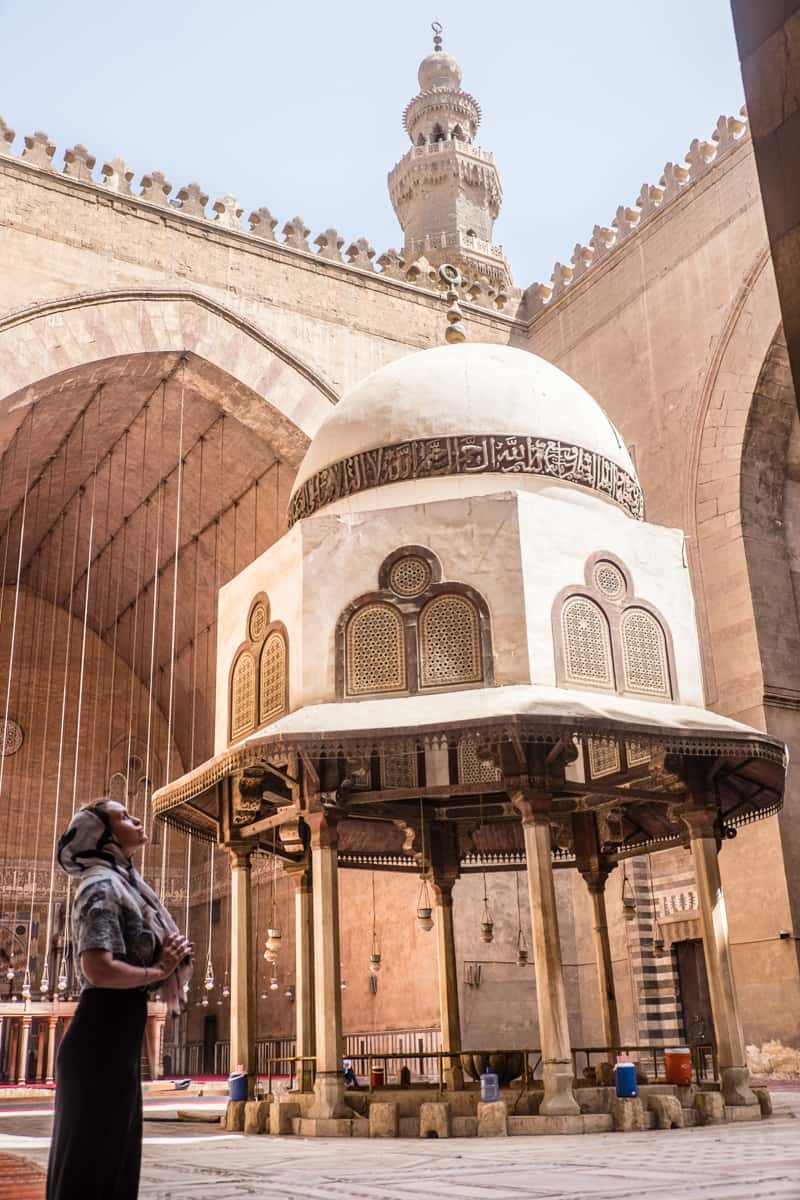
What to Pack for Egypt
Explorer Essentials
- Camera, with an extra battery (which is quickly exhausted in the heat) and additional memory cards because you will not stop snapping away at the ancient marvel in front of your eyes. The photography ticket price is worth it for the memories.
- Small day pack or shoulder bag to only carry the essentials in the heat when you are at the famed sites.
- Sunscreen – and a lot of it. You will have constant exposure to the sun.
- Insect repellant and bite cream – especially since sandflies can be at full force.
- Pack a pair of earplugs, bag locks, an international outlet adaptor, a head torch, a microfiber towel, water bottle and a first aid kit. These are essential extras for a comfortable trip where you are moving around a lot and taking multiple transportations.
- Toiletries – while there are local stores and pharmacies around, you might not find everything you need or the hotel is a little far from the very centre of the city. Bring all your essentials with you.
- Take a book or arrange all your favourite Netflix downloads for those long journeys. The Internet in Egypt is unreliable, so prepare everything before you leave.
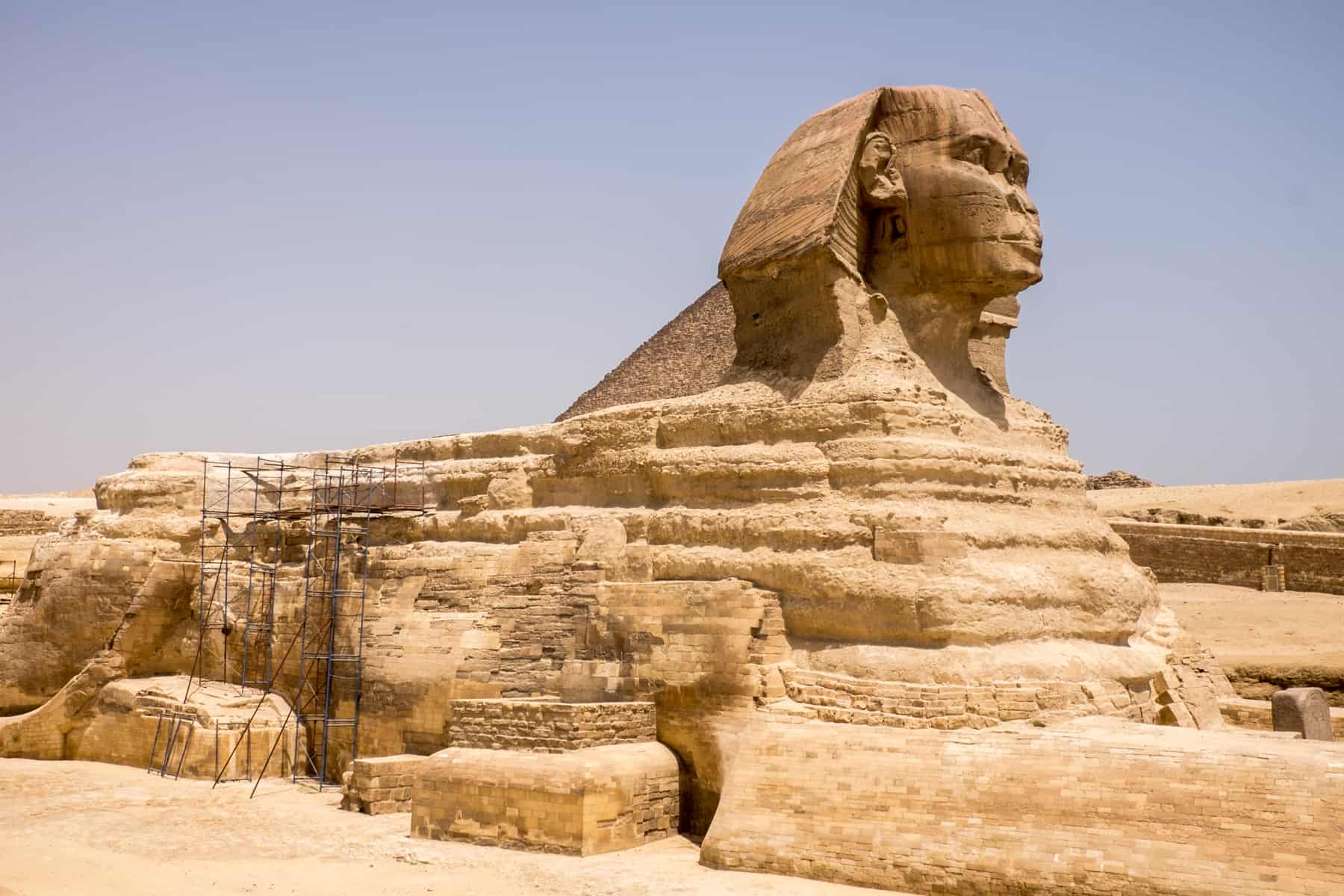
Money, Tipping and Haggling
Money Exchange in Egypt
The currency used in Egypt is the Egyptian Pound (EGP), which you will see abbreviated in stores and eateries as LE. You can check the live currency conversion here.
There are ATMs in all major cities in Egypt as well as the large hotels, which accept Visa and MasterCard. We had various nationalities of people in the group, and all cards worked fine (although charges are different for each person according to your bank).
There was a currency exchange at my hotel in Cairo, and there are money exchanges readily available. Euros, British Pounds and US Dollars (new and in good condition) are all easy to exchange to Egyptian Pounds.
I travelled with both a visa and MasterCard credit card as a backup but chose to take around 600 Euros in cash for the ten days to exchange in small amounts as I went along. Extra excursions had to be paid in cash, so this was particularly useful to have at hand quickly. However, carrying money has a higher risk, and I always travel with a portable safe.
Also have cash handy for ticket costs and the extra money needed for photography permission at sites – this extra 50 EGP ticket is worth the additional cost to capture those memories.
Tipping in Egypt and the Concept of Baksheesh
Baksheesh – which operates as either a tip or a bribe – is standard in Egypt. Which category it falls under is determined by the situation, and its interchangeability and existence is a part of everyday life in Egypt and cultural custom.
Baksheesh as Tipping
Generally, when it comes to goods and services, tipping is common.
- Tipping your drivers, guides and service workers
Give 15-30 EGP ($1-2) tip per person, and service industries such as hotel and restaurant staff where you may round up the bill to a lump sum or add 10% of the total as the tip.
Our G Adventures guide collected a lump sum from us at the beginning of our trip and organised the tipping throughout our trip, which saved us all trying to find a dollar (around 15 EGP) here and there.
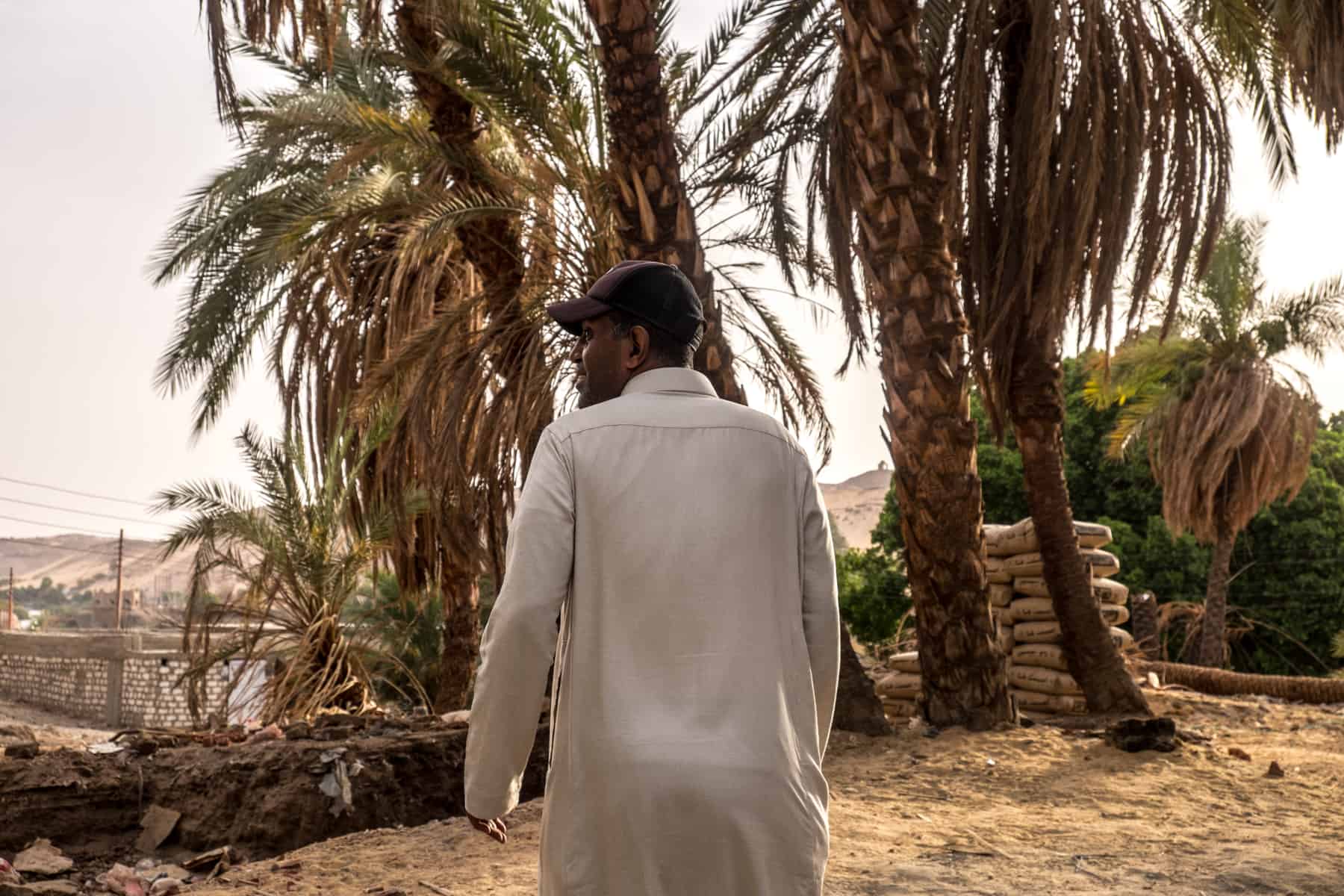
- Want to use the toilet at one of the main sites?
You will need to tip the toilet attendant about 5 EGP. Often we would go in pairs if we only as 10 EGP notes.
- You are leaving your shoes outside the Mosque, as is required?
You will need to tip the man who is the guardian of the shoes. Again, around 5 EGP is sufficient.
- Want a picture of a camel at the Pyramids? Or of one of the well-dressed guards at the temples?
It is always polite, and ethical, to ask someone if you can take a photo of them – but in this case, expect to pay for it, or “give a little baksheesh” as the saying goes.
More often than not, the camel ride vendors and guards are naturally in the background and not in your direct line of vision for your photo subject. Therefore you somehow get lucky with your shot, but don’t think you can outsmart these guys if you are cheeky – they will come and ask for their baksheesh.
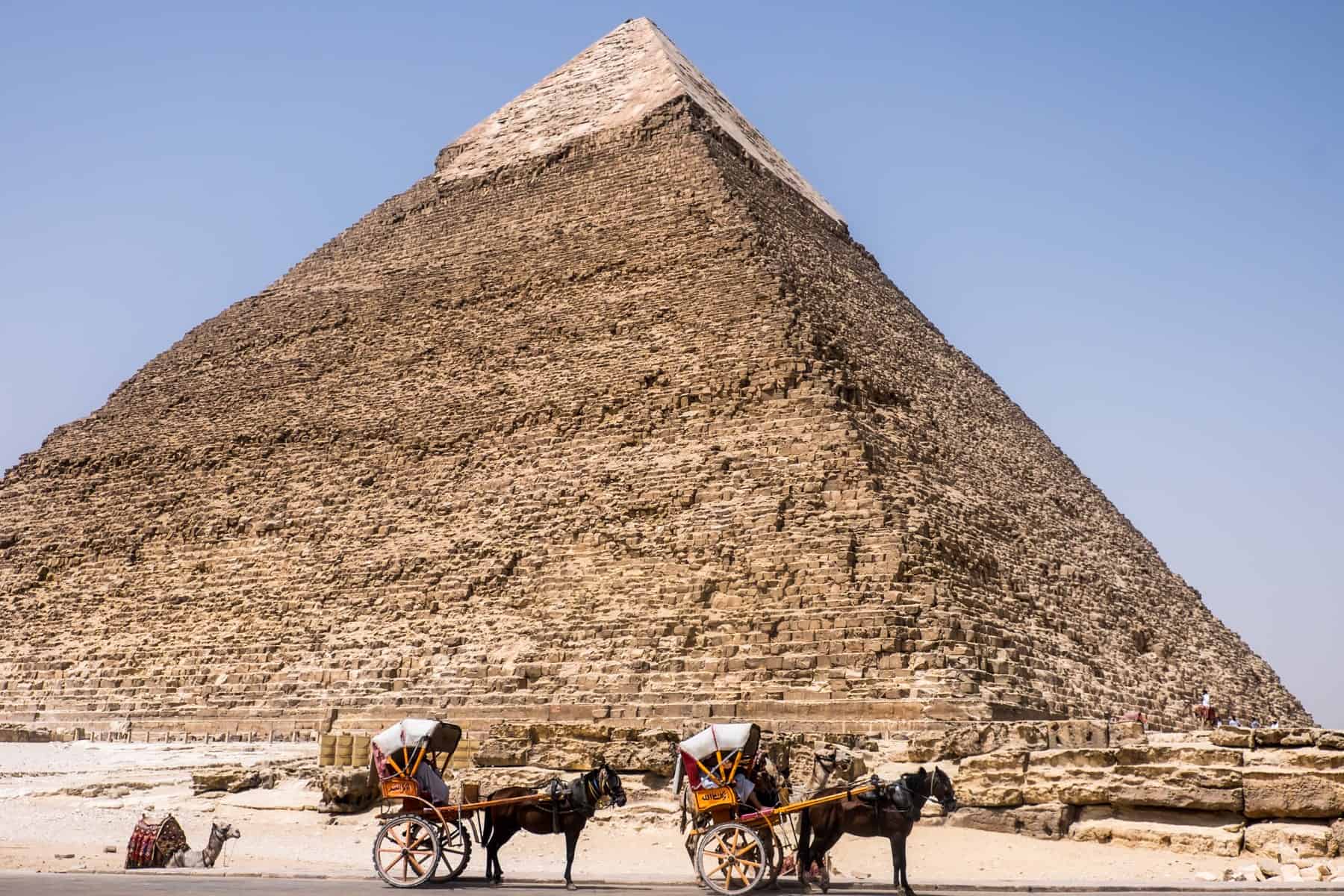
Baksheesh as a Bribe
- The guards and vendors at sites are also masters of knowing how to get in your picture before demanding baksheesh.
This situation can be fairly aggravating when you are trying to take a picture of a wall carving or a pillar, and the guards always jump in your shot. Be assertive and simply tell them your photo does not require them in it. I found this behaviour particularly rampant at the Temple of Hatshepsut.
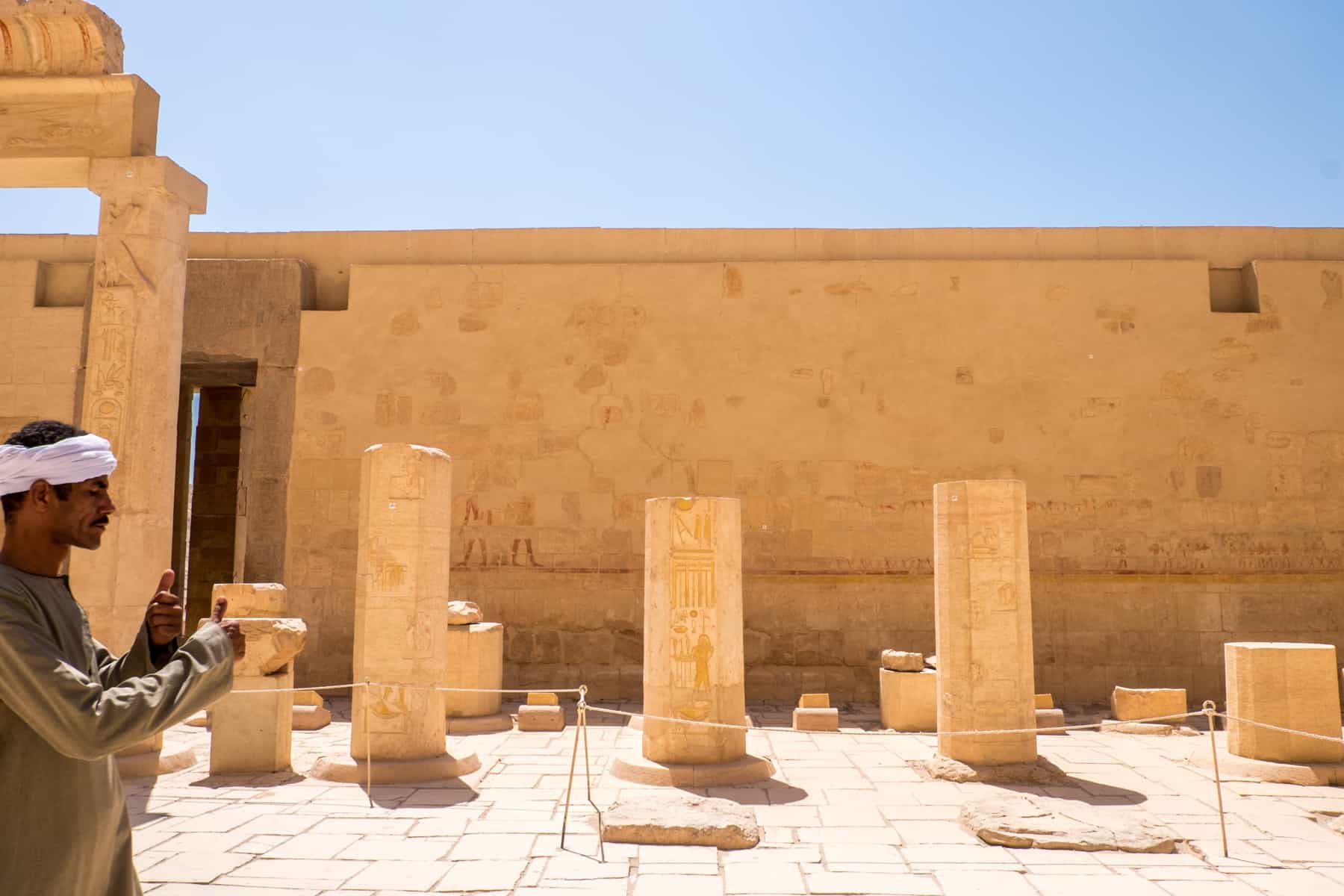
- Resist the offer for exclusive access at temples and sites
At some temple sites, a guard might offer you access to see an extra room or area of the construction situated behind a roped-off area. Want to see it? Expect to be asked to hand over a little baksheesh for the pleasure of your extra sightseeing.
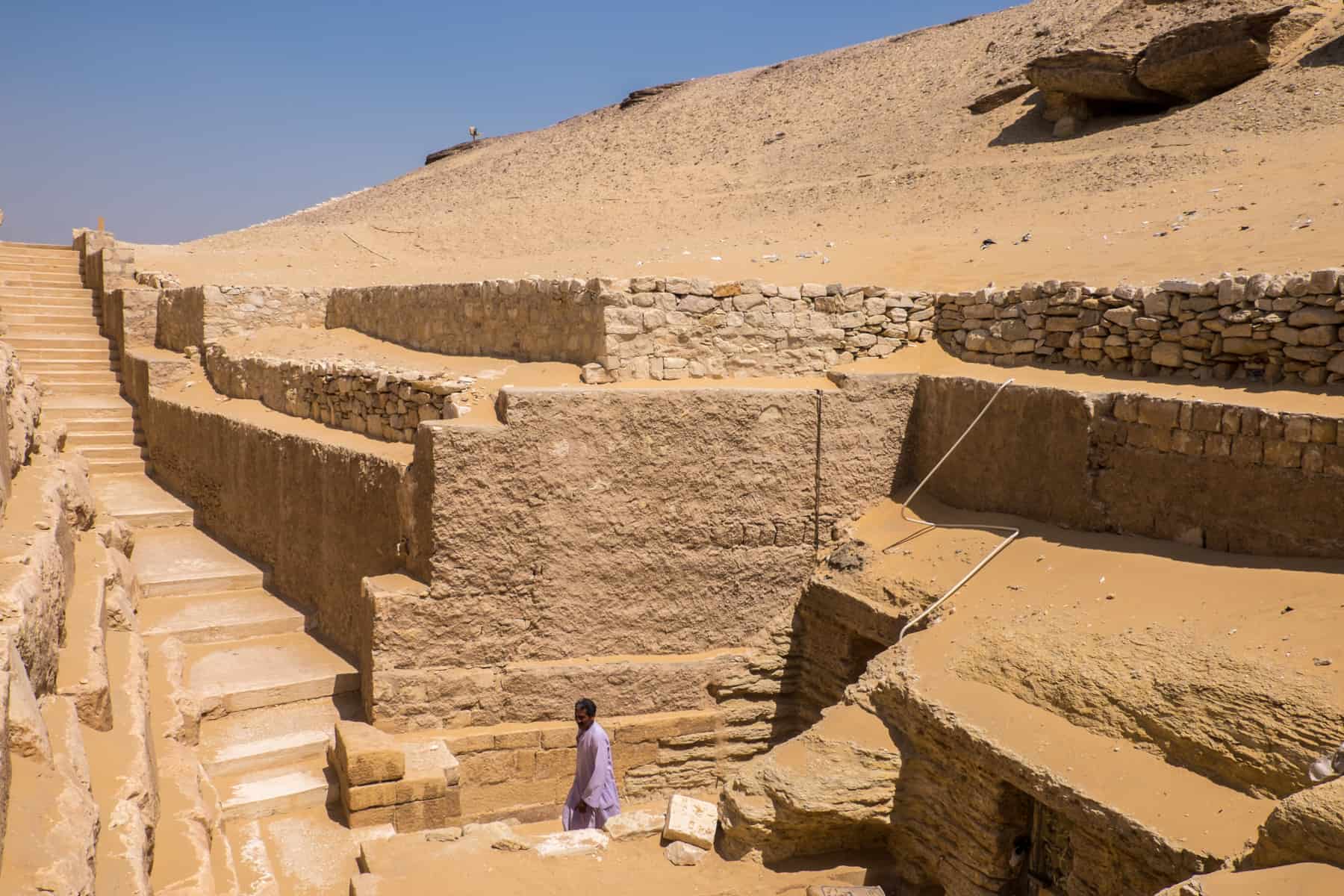
Haggling in Egypt
Never hand over the money in an Egyptian souk or market on the first price given. The haggling process is expected here and a part of the culture, so don’t be afraid to enter negotiation mode on everything from spice to large souvenirs.
The easiest way to begin the haggling process is to half the original price offered, and know what you want to pay overall so that you can go back and forth and get as close to that. Enjoy the process, even if it can be quite the effort and know that it’s OK to walk away and end the bartering if you are not happy with the final offer.
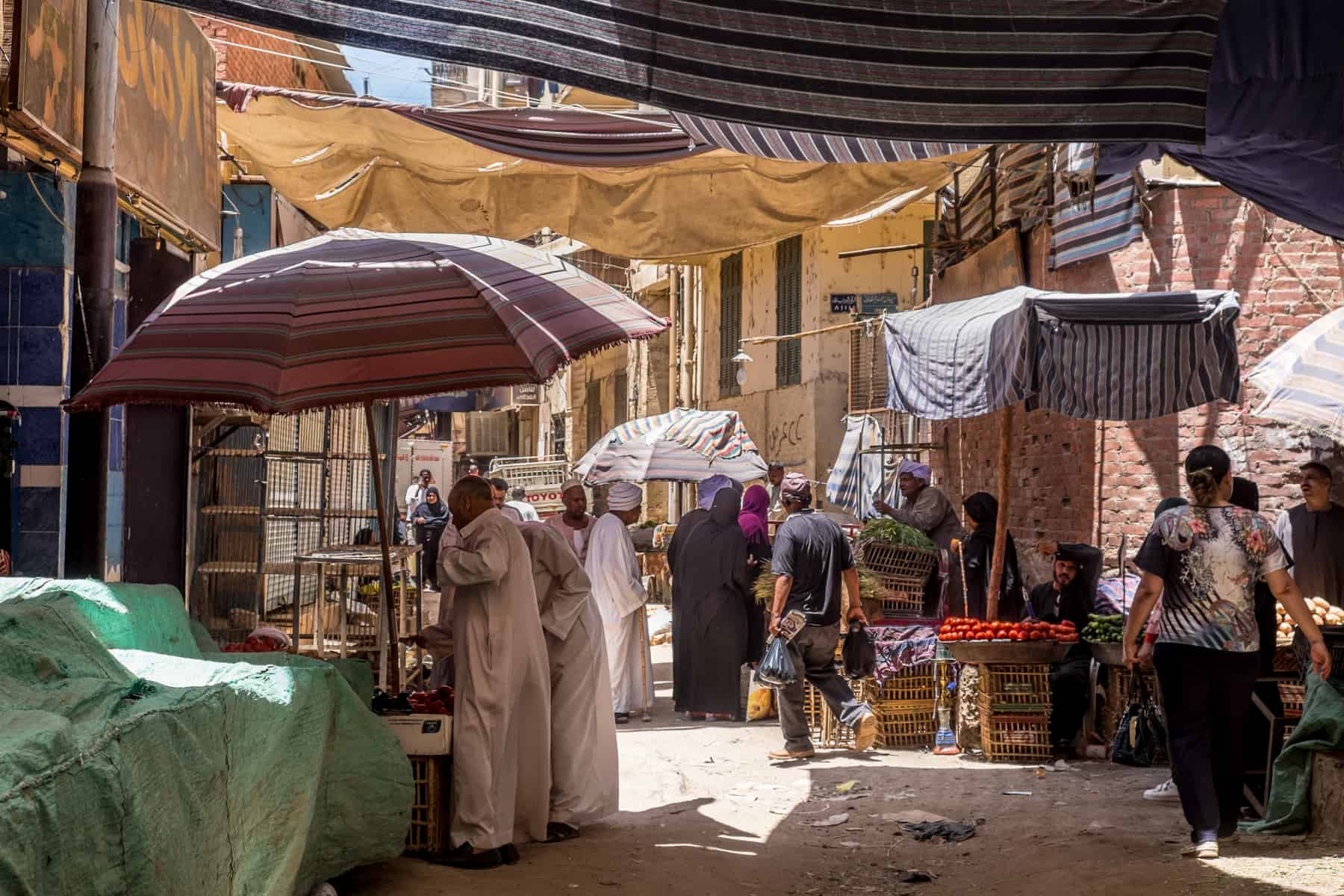
Egypt’s list of mega sights and the continuous delicate tourism situation means travel here can be overwhelming. Yet that doesn’t mean it’s inaccessible. Travelling for purpose, in wanting to uncover the rich history of Egypt alongside its fabled culture, makes a trip here rewarding beyond ancient sightseeing.
Good preparation perhaps? Given the fact Egypt is uncovering more of its archaeological repository and recovering from tourism setbacks, Egypt is certainly not a one-time visit destination.
Any plagiarism of this Egypt travel blog or any of its descriptions used on other sites and blogs without attribution is not information authorised by myself for use. Know your source.
The post How to Travel to Egypt Safely & Responsibly – Overturning Negative Perceptions appeared first on Borders Of Adventure.
from Borders Of Adventure https://www.bordersofadventure.com/travel-to-egypt-guide/
VietNam Travel & Food Magazine Vina.com offers News✅ Travel info✅ Food Recipes✅ Photos✅Restaurant Guide at Vina.com https://vina.com/travel/nightlife/ https://vnfoodandtravelblog.blogspot.com/

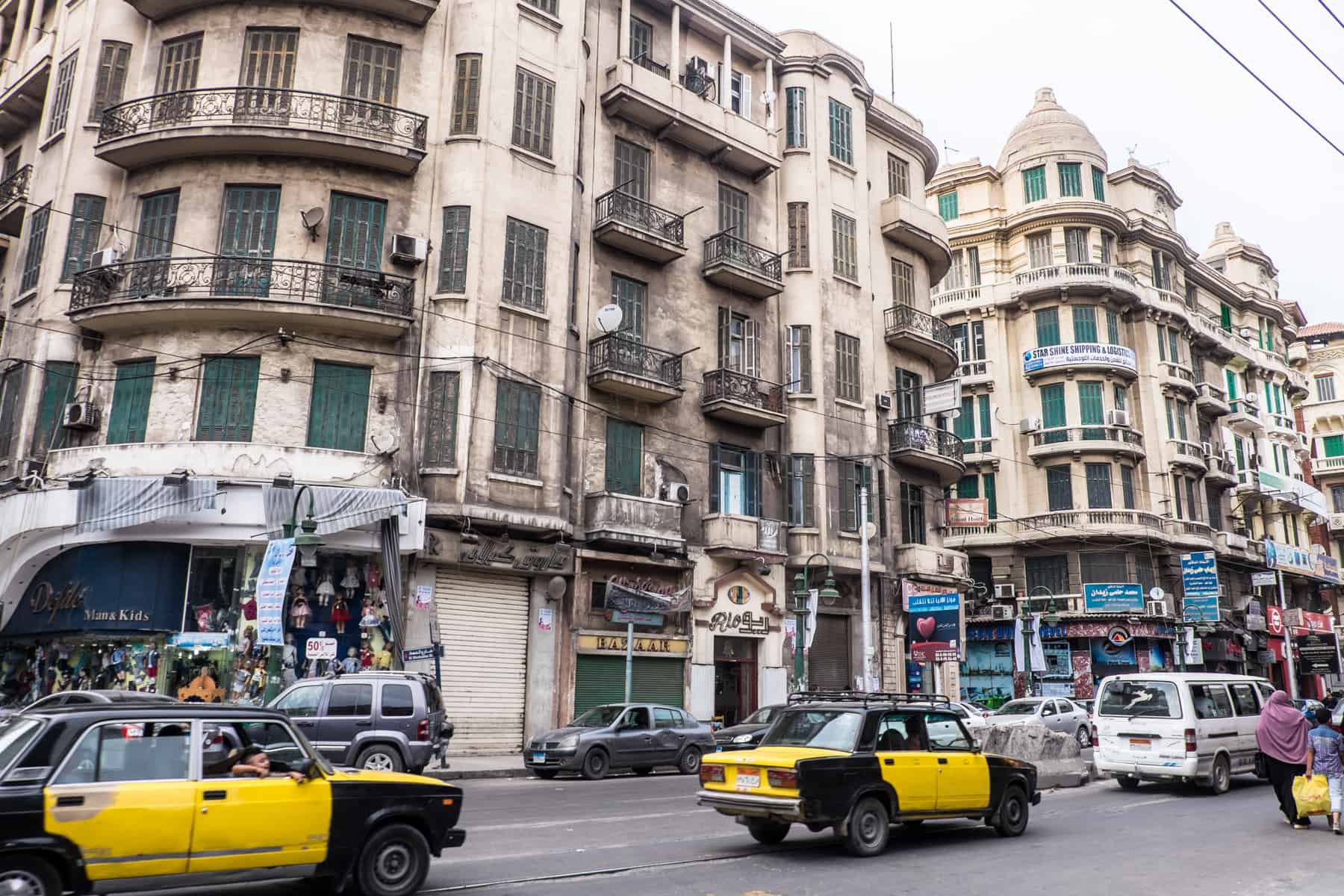


0 Nhận xét